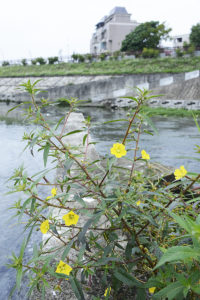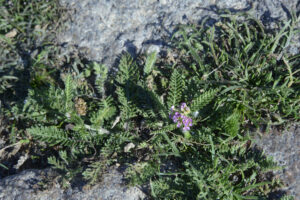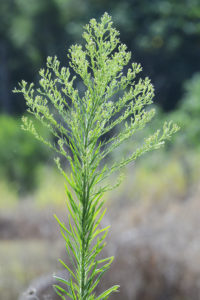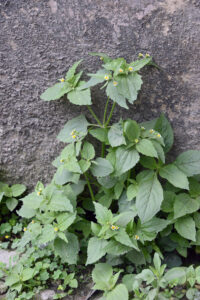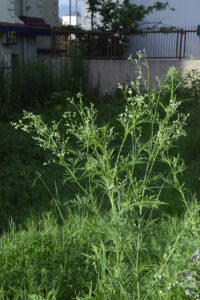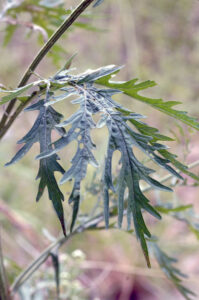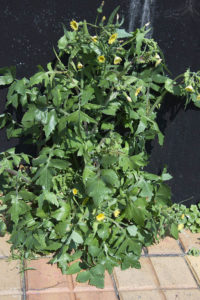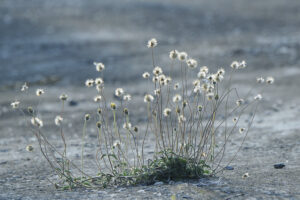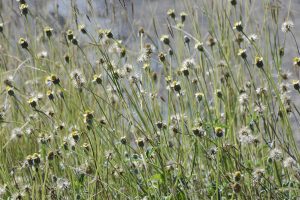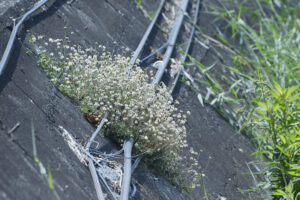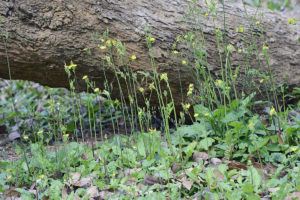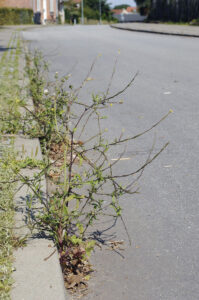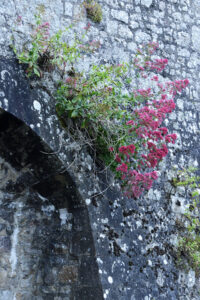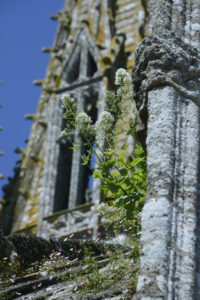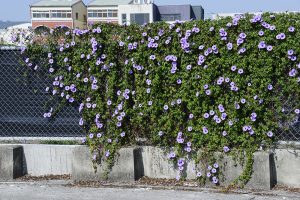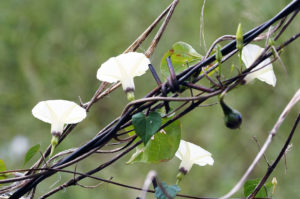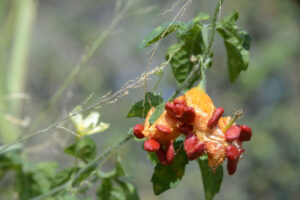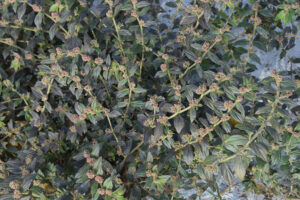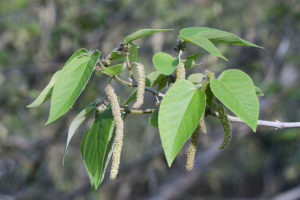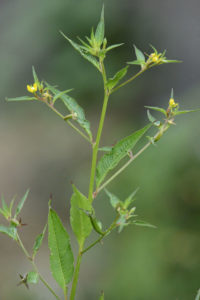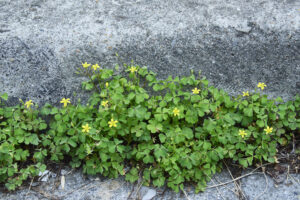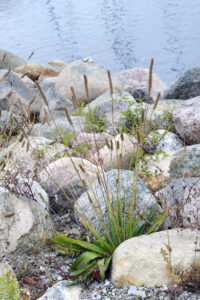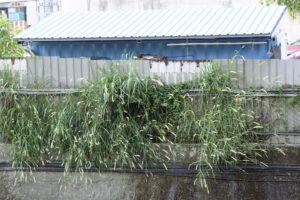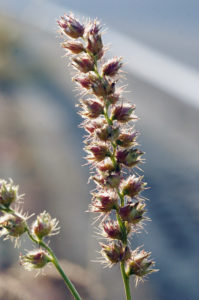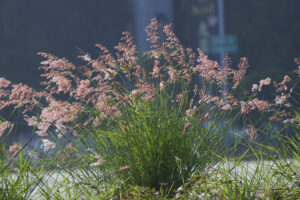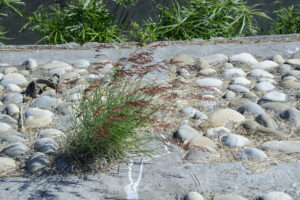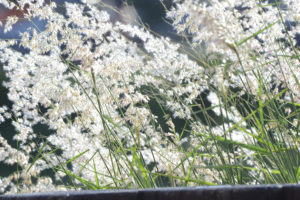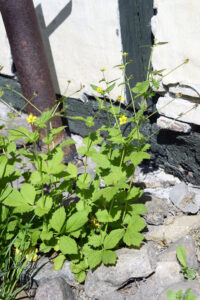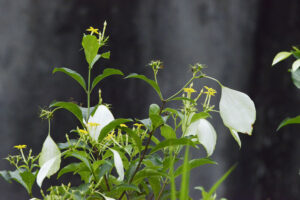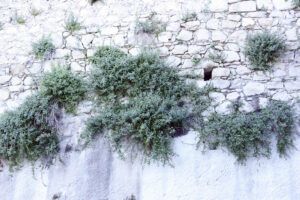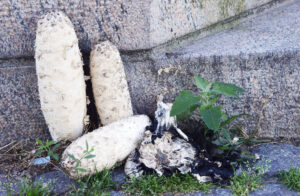Urban plant life
Railroad creeper (Ipomoea cairica, Convolvulaceae), creeping along barbwire, Taichung, Taiwan. (Photo copyright © by Kaj Halberg)
This spreading pellitory-of-the-wall (Parietaria judaica, Urticaceae) has sprouted in a hole on a house wall, Sultanahmet, Istanbul, Turkey. (Photo copyright © by Kaj Halberg)
Mexican primrose-willowherb (Ludwigia octovalvis, Onagraceae), growing along the Han River, Taichung, Taiwan. (Photo copyright © by Kaj Halberg)
This Asiatic dayflower (Commelina communis, Commelinaceae) has sprouted in a crack along a house wall, Taichung, Taiwan. (Photo copyright © by Kaj Halberg)
Withered peacock-plume grass (Chloris barbata, Poaceae) is often very decorative. These specimens are illuminated by the morning sun against a dark wall in the city of Taichung, Taiwan. The small plants are lantern tridax (Tridax procumbens, Asteraceae). (Photo copyright © by Kaj Halberg)
Traditionally, fungi and lichens were regarded as plants, and although they now belong to separate kingdoms, I include them here, as most people still regard them as plants. A few species are presented at the bottom of the page.
Acanthaceae Acanthus family
A huge family, counting about 229 genera with c. 4,000 species of herbs, shrubs, climbers, or trees, distributed in most parts of the world.
A popular name of this family is bear’s breeches family. This strange name builds on a misunderstanding. A medieval Latin name of the plant, which Swedish botanist Carl Linnaeus (1707-1778), later named Acanthus mollis, was Acanthus sativus branca ursina (‘cultivated spiny (plant with) bear bracts’), alluding to the curved bracts of the inflorescence, which, to those who named the plant, apparently resembled a bear’s claws. Over time, branca was corrupted to breech, leading to the name bear’s breeches.
Ruellia
This huge genus, containing about 365 species, native to tropical and subtropical areas in the Americas, Africa, southern Asia, and Australia. They are sometimes called wild petunias due to their resemblance to true petunias (Petunia), of the nightshade family (Solanaceae).
The generic name honours French herbalist and physician Jean Ruelle (1474-1537), who translated works of Greek physician, pharmacologist, and botanist Pedanius Dioscorides (died 90 A.D.), who was the author of De Materia Medica, 5 volumes dealing with herbal medicine.
Ruellia tuberosa
This species is native to Central America, but is widely cultivated elsewhere and has become naturalized in several places, including eastern Africa, the Indian Subcontinent, and Southeast Asia.
Naturalized Ruellia tuberosa, growing in a crack in a wall along a drainage canal, Taichung, Taiwan. (Photo copyright © by Kaj Halberg)
Amaranthaceae Amaranth family
This worldwide family contains about 174 genera with 2,100 to 2,500 species of herbs or shrubs, rarely trees or climbers. Many of the species were formerly in the goosefoot family (Chenopodiaceae), which is now regarded as a subfamily, Chenopodioideae, of the amaranth family.
Alternanthera
Members of this genus are characterized by their whitish, papery flowers. The number of species varies enormously, from 80 to 200, depending on authority. These plants, also known as joyweed or Joseph’s coat, mainly stem from South America, with some species native to Asia, Africa, and Australia. Many species have been accidentally introduced elsewhere, and several are regarded as noxious weeds.
The generic name is derived from the Latin alternus (‘alternate’), and Ancient Greek anthera (‘anther’), presumably referring to the anthers being alternately fertile and barren.
Alternanthera sessilis Sessile joyweed
This creeping plant is native to South America, but has been spread to more than 30 countries in warmer regions around the world. It is a pioneer plant, growing in a wide range of habitats, including marshes, margins of streams, damp forests, and open disturbed areas, such as lawns and abandoned plots. It is also a weed in fields.
In many places, it has become a huge problem in water courses, as it may block the flow of water. It is listed as invasive in a number of countries, including Spain, United States, New Zealand, India, China, Taiwan, Namibia, and South Africa.
The specific name refers to the unstalked inflorescences.
Sessile joyweed is very common in Taiwan, also in cities. These have sprouted in a crack in a pavement (top), and in an abandoned plot, Taichung. (Photos copyright © by Kaj Halberg)
Amaranthus Pigweed, amaranth
A worldwide genus with about 75 species.
In his delightful book All about Weeds, Dover Publications (1974), American botanist Edwin Spencer (1881-1964) says about a species of pigweed, A. retroflexus:“One of the most robust, devil-may-care weeds is the pigweed. ‘Careless weed’ is another of its common names, and it comes by this name honestly enough. In good rich soil, it cares for nothing. Wind, hail, fair weather and foul are all the same to the pigweed. Nor does it care what plants are its competitors. It can usually shoulder our any plant within reach, and it has a considerable reach. The name pigweed, however, has no reference to the piggish nature of the plant. It refers to the gustatory pleasure the weed affords pigs. Hogs will leave their corn to feast on pigweeds. In spite of its bristly appearance (it always reminds one of a boisterous young sailor with a week’s growth of sandy beard on his face and his cap on the side of his head), the leaves are tender, and if the smacking of lips and satisfied grunts mean the same thing to pigs that they do to Man, the weeds must be delicious.”
The generic name is derived from Ancient Greek a (‘not’, ‘without’) and maraino (‘to wither’), given in reference to the flowers, which last a very long time.
Amaranthus viridis Slender amaranth
The native area of this species, also known as green amaranth, is unknown, and today it is distributed in all warmer areas of the world.
Leaves, as well as seeds, are eaten in many parts of the world. In Australia, this plant was also a source of food during the 19th Century. In 1889, botanist Joseph Maiden (1859-1925) wrote: “It is an excellent substitute for spinach, being far superior to much of the leaves of the white beet sold for spinach in Sydney. Next to spinach it seems to be most like boiled nettle leaves, which when young are used in England, and are excellent. This amarantus should be cooked like spinach, and as it becomes more widely known, it is sure to be popular, except amongst persons who may consider it beneath their dignity to have anything to do with so common a weed.” (Source: T. Low, 1985. Wild Herbs of Australia & New Zealand. Angus & Robertson)
In India, slender amaranth is utilized in traditional Ayurvedic medicine.
The specific name is Latin, meaning ‘green’.
In Taiwan, slender amaranth is very common in cities, especially in fallow areas, and along roads and embankments. These pictures are all from Taichung. (Photos copyright © by Kaj Halberg)
Celosia Cockscomb
This genus contains about 45 species, native to tropical and subtropical areas of Central and South America, Africa, Arabia, and the Indian Subcontinent.
The generic name is derived from Ancient Greek keleos (‘burning’ or ‘blazing’), alluding to the colourful inflorescences.
Celosia argentea Silver cockscomb
Like the slender amaranth, the native area of this species, also called feathery amaranth, is unknown, and today it is found in most tropical and subtropical areas of the world. It is regarded as an invasive plant in numerous countries, including India, Japan, Ecuador (Galapagos Islands), Fiji, Taiwan, and the United States.
The specific name is Latin, meaning ‘silvery’, like the common name alluding to the ripe inflorescences, which shine like silver.
Silver cockscomb is described in depth on the page Plants: Plants in folklore and poetry.
Silver cockscomb is abundant in Taiwan, also in cities, where it often grows in abandoned plots, in this case in Taichung. Downy bur-marigold (Bidens pilosa, see below), likewise an invasive species, is also seen in the picture. (Photo copyright © by Kaj Halberg)
Silver cockscomb, growing in an abandoned parking lot, Taichung. (Photo copyright © by Kaj Halberg)
In this picture, silver cockscomb completely covers the bottom of a drainage canal in Taichung. (Photo copyright © by Kaj Halberg)
Anacardiaceae Sumac family
This family, comprising about 83 genera with c. 860 species, is native to tropical and subtropical areas around the world, with a few species occurring in temperate regions. Several species are economically important fruit and nut crops, including the cashew tree (Anacardium occidentale).
The family name is derived from the Greek ana (‘upwards’) and kardia (‘heart’), alluding to the heart of the fruit (the ‘nut’) of the cashew nut, which is outwardly located.
Rhus Sumac
Sumacs are a genus of c. 35 species, distributed in subtropical and temperate areas, especially around the Mediterranean, and in Asia, Australia, and North America. Other species, which were formerly placed in Rhus, have now been transferred to the genus Searsia, others to Toxicodendron, including poison ivy and poison oak, described on the page Autumn.
The word sumac is derived from Ancient Syriac summaq (‘red’), referring to the red fruits of the genus. They have an acrid taste and are used as a spice. In North America, the fruits of staghorn sumac (Rhus typhina) are soaked in cold water to make ‘pink lemonade’, a refreshing beverage, rich in vitamin C.
Rhus coriaria Elm-leaved sumac
This species, also known by other names, including tanner’s sumac and Sicilian sumac, is native from the entire Mediterranean region eastwards through the Caucasus and the Middle East to Kyrgyzstan and Afghanistan. It is also found on the Canary Islands and Madeira.
It is a shrub, growing to 5 m tall, leaves pinnately divided, with 7-8 pairs of ovate leaflets. The inflorescence is a terminal cluster of small white flowers, which later become brownish-red or greenish-yellow drupes, with a very acidic taste. They are dried and crushed to be used as a spice, which, together with other spices, form a mixture called za’atar.
Leaves and bark contain tannic acid and were formerly used in leather tanning, hence the specific name, derived from the Latin coriarium (‘leather’ or ‘tanning’). Various parts of the plant yield red, yellow, black, or brown dyes. Oil from the seeds are utilized to make candles.
Elm-leaved sumac is very common in Turkey. This one has taken root on the wall of an abandoned house in Sultanahmet, Istanbul. (Photo copyright © by Kaj Halberg)
Apiaceae (Umbelliferae) Carrot family
A huge worldwide family, containing about 434 genera with c. 3,700 species of herbs. Many species are economically important crops.
The inflorescence of this family is unique. In almost all species, the flowers are arranged in terminal umbels, which may be simple, usually with bracts at the base, and each of the stalks, the so-called primary rays, ending in a flower. More commonly, the umbel is compound, consisting of a number of primary rays, each ending in a secondary umbel. Each of these umbels usually has small bracts, bracteoles, at the base, and a number of secondary rays, each ending in a flower. Usually, the secondary umbels together form a flat-topped inflorescence, mostly with white, yellow, pink, or purple flowers, rarely blue or bright red. The flowers have five petals and stamens. This also accounts for the sepals, if they are present. They are usually missing, however.
The family name is derived from the name of honey bees, genus Apis, referring to the fact that many plants of the family are much visited by bees and other nectar-sucking insects, in particular hovering flies.
Aegopodium
A genus with 12 species, found in Eurasia.
The generic name is explained below.
Aegopodium podagraria Goutweed
As far back as Ancient Rome, and throughout the Middle Ages, young leaves of goutweed were utilized as a vegetable, much as spinach is used. The generic name is from the Greek aix, genitive aigos (’goat’), and podion, diminutive of pous (’foot’), thus ‘little goat-foot’, referring to the shape of the leaves. According to the Doctrine of Signatures, Our Lord had shaped the plants, so that humans were able to discover what ailments they could be used for. Therefore, goutweed must be an effective remedy for gout. Medicinally, however, there is no basis for this assertion. It was also used as a laxative.
Goutweed is native to southern Europe and western Asia, but was introduced as a garden plant to northern Europe as early as the Middle Ages. It has also been accidentally introduced to North America, and almost everywhere it has become a most annoying garden weed.
In this picture, goutweed is growing out through a beech hedge alongside a pavement. – Jutland, Denmark. (Photo copyright © by Kaj Halberg)
Goutweed as a garden weed, Funen, Denmark. (Photo copyright © by Kaj Halberg)
Chaerophyllum Chervil
A genus with about 35 species, native to Europe, North Africa, Asia, and North America.
The generic name is derived from Ancient Greek khairephyllon, from khairo (‘to be glad’) and phyllon (‘leaf’), the classical name of garden chervil (Anthriscus cerefolium), a culinary herb, which is much used in Mediterrenean kitchens. Botanically speaking, however, the word chervil also applies to members of the genus Chaerophyllum.
Chaerophyllum temulum Rough chervil
This pioneer plant is found in a variety of habitats, including forest edges, waste places, and along walls and fences. It is distributed in the major part of Europe, eastwards to the Ural Mountains, the Caucasus, and Turkey, and also in north-western Africa.
The purplish, very hairy stem grows to about 1 m tall, leaves long-stalked, twice or thrice pinnate, pale or dark green, lobes ovate in outline, deeply toothed. Flowers are white. The plant is poisonous.
The generic name is derived from the Greek chairo (‘to please’) and phyllon (‘leaf’), thus ‘with pleasant foliage’. The specific name is from the Latin temulentum (‘drunken’), derived from temetum (‘an intoxicating drink’) and ulentus (‘full of’), alluding to the symptoms from poisoning by the plant being similar to those of alcoholic intoxication.
Rough chervil, growing at a house wall, Funen, Denmark. (Photo copyright © by Kaj Halberg)
Apocynaceae Dogbane family
This almost worldwide family contains about 415-425 genera with c. 4,500 species of trees, shrubs, or climbers, rarely herbs.
The family name is derived from Ancient Greek apo (‘away’) and kyon (‘dog’), alluding to the toxic dogbane (Cionura erecta), which was formerly utilized to poison dogs.
A large number of genera in this family formerly constituted the milkweed family (Asclepiadaceae), which is today regarded as a subfamily, Asclepiadoideae, of the dogbane family. An amusing description of the peculiar pollination method in the genus Asclepias is found on the page Plants: Plants in folklore and poetry.
Catharanthus Periwinkle
A small genus with 8 species, all but one endemic to Madagascar, with a single species, C. pusillus, native to India and Sri Lanka. Previously, these plants were included in the genus Vinca.
The generic name is derived from Ancient Greek katharos (‘pure’) and anthos (‘flower’).
Catharanthus roseus Madagascar periwinkle
This pretty plant is native to Madagascar, but is widely cultivated in warmer areas as an ornamental and sometimes escapes cultivation. It is also widely used as a medicinal plant, as it is a source of drugs, used in the treatment of cancer.
Madagascar periwinkle, growing in a crack in a concrete wall along a drainage canal, Taichung, Taiwan. (Photos copyright © by Kaj Halberg)
Aspleniaceae Spleenwort family
According to Kew Gardens, London, this family of ferns today contains 24 genera, distributed almost worldwide, with the exception of Antarctica and the high Arctic. They grow in soil, on rocks, or as epiphytes, and a few are aquatic.
Asplenium Spleenwort, bird’s-nest ferns
This huge genus, comprising about 700 species, is found in almost all parts of the world. They differ in size from tiny plants to the huge epiphytic bird’s-nest ferns, some of which grow to more than 1 m across, with fronds up to 1.5 m long.
The generic name is derived from Ancient Greek asplenon, the classical name of spleenworts, ultimately from splen (‘spleen’), alluding to its usage to cure anthrax in livestock.
Asplenium ceterach Rusty-backed fern
This evergreen fern, previously known as Ceterach officinarum, grows in cracks in limestone rocks, and on old walls. It is distributed from the British Isles and Germany southwards to northern Africa, and thence eastwards to Kazakhstan, Xinjiang, and Tibet, found from sea level up to elevations around 2,700 m.
It is a small, compact fern, growing to about 20 cm tall, fronds narrowly elliptic in outline, to 8 cm long and 1.6 cm broad, pinnately divided into 6-8 alternate, triangular pairs. The underside is covered in a dense layer of pale reddish-brown scales, giving rise to the common name. The leaves roll up in hot weather, displaying the scaly underside.
Previously, this fern was much utilized as a medicinal herb for treatment of a large variety of ailments.
The specific name is an ancient name of this plant, derived from the Persian name of it, cedracca.
Rusty-backed fern, growing on a churchyard wall, Hirel, Brittany. (Photo copyright © by Kaj Halberg)
Asplenium ruta-muraria Wall-rue
This small fern grows exclusively on limestone and other calcareous rocks, including walls of old buildings. The fronds are green or bluish-green, much divided, up to 12 cm long. The sporangia clusters are blackish-brown, situated on the underside of the leaflets.
It is a very widespread plant, found in all of Europe, eastwards across most of Siberia, in North Africa, the Middle East, Central Asia, the Himalaya, and China. In Central Asia, it grows up to elevations of c. 3,300 m.
The specific and common names refer to the fact that it often grows on walls, and to the likeness of its leaves to those of common rue (Ruta graveolens).
Wall-rue, growing on an old wall, St. Malo, Brittany. (Photo copyright © by Kaj Halberg)
Asplenium trichomanes Maidenhair spleenwort
A small plant, forming tufts from a short, scaly rhizome. The evergreen fronds are narrow, usually to 20 cm long, sometimes to 30 cm, gradually tapering towards the tip, pinnately divided into small, rounded or slightly elongated, yellowish-green to dark green leaflets. The rachis (stem of the frond) is brownish-black. Sporangia clusters small, 1-3.5 mm long, on the underside of the leaflets.
This plant is very widely distributed, found in scattered locations in most parts of the world, growing in rocky habitats and on walls, from sea-level up to about 3,000 m. It is fairly common in the Pyrenees and the Alps.
This species and its near relatives were much utilized in traditional herbal medicine. Greek physician, pharmacologist, and botanist Pedanius Dioscorides (died 90 A.D.) and Roman naturalist Pliny the Elder (23-79 A.D.) both distinguished between a pale and a black adianton. They were variously called polytrichon (‘many hairs’), kallitrichon (‘fair hair’), trichomanes (‘fine hair’), and capillus veneris (‘venus hair’). They were supposed to possess general anti-toxic properties, used as a diuretic, to expel kidney stones, to cure pulmonary problems, jaundice, spleen diseases, and skin ailments, and to promote hair growth.
The specific name is explained above.
Maidenhair spleenwort, growing on the algae-covered wall of Basilique Saint-Sauveur, Dinan, Brittany. (Photo copyright © by Kaj Halberg)
Blechnum Hard ferns
A large genus with about 240 species, found in most parts of the world, with the exception of the polar regions, Siberia, north-eastern North America, and desert areas.
The generic name is derived from blechnon, an Ancient Greek term for ferns in general.
These plants were formerly placed in a separate family, Blechnacae, which is today regarded as a subfamily of the spleenwort family.
Blechnum orientale Oriental hard fern
This large fern, with fronds sometimes reaching a length of 2 m, is distributed from the Indian Subcontinent eastwards to southern China, Taiwan, and southern Japan, and thence southwards through Southeast Asia to New Guinea, Australia, and islands in the western Pacific. Elsewhere, it is cultivated as an ornamental, and plants are sometimes harvested from the wild to be used for food or medicine.
Oriental hard fern, growing on a humid house wall, Hanoi, Vietnam. (Photo copyright © by Kaj Halberg)
This oriental hard fern is clinging to a crack in a wall along a drainage canal, Taichung, Taiwan. (Photo copyright © by Kaj Halberg)
In this picture, oriental hard fern is growing on a concrete wall along the Suei Wei River, Taichung. (Photo copyright © by Kaj Halberg)
This one is growing in a crack along a balcony, Hanoi. (Photo copyright © by Kaj Halberg)
Asteraceae (Compositae) Daisy family
This worldwide family is one of the largest, comprising about 1,620 genera with c. 24,000 species of herbs or shrubs, rarely climbers or trees.
The inflorescence consists of many individual flowers, called florets, which are grouped densely together to form a flower-like structure, the flowerhead, technically called the capitulum. The flowerhead is surrounded by an involucre, consisting of densely packed green bracts, often erroneously called a calyx. The central disk florets are symmetric, and the corolla is fused into a tube. The outer ray florets are asymmetric, the corolla having one large lobe, which is often erroneously called a petal. In some species, ray florets, or sometimes disk florets, are absent.
Achillea Yarrow, milfoil, sneezewort
A large genus of about 200 species, found mainly in Europe and temperate areas of Asia.
English herbalist John Gerard (c. 1545-1612) informs us that during the Trojan War the Greek hero Achilles used yarrow to stop bleeding on wounded soldiers. Hence, the name Achillea was applied to the genus by Swedish naturalist Carl Linnaeus (1707-1778). It was already mentioned as a medical herb in De simplicium medicamentorum facultatibus, written by Greek-Roman physician, surgeon, and philosopher Aelius Galenus (c. 129-210 A.D.), also known as Claudius Galenus or Galen of Pergamon.
Various plants, including yarrow, were found in a 50-60,000-year-old Neanderthal grave in Iraq, perhaps indicating that these plants were used medicinally. (Source: G.P. Shipley & K. Kindscher 2016. Evidence for the Paleoethnobotany of the Neanderthal: A Review of the Literature. hindawi.com/journals/scientifica/2016/8927654)
The name yarrow is a corruption of gearwe, an ancient Anglo-Saxon name for common yarrow (below).
Achillea millefolium Common yarrow
A widespread plant, to 90 cm tall, found in temperate areas of Eurasia and North America, mainly growing in disturbed areas, along roads and ditches, and in fallow fields. It was introduced as a fodder plant to Australia and New Zealand, where it has become naturalized in several areas. In montane areas of south-eastern Australia, it is regarded as an invasive weed.
The greyish-green leaves are very finely dissected, aromatic, to 10 cm long. Flowerheads are numerous, sometimes up to 50, borne in a flat or slightly domed cluster to 30 cm across. Ray florets are white, much larger than the tiny yellowish or cream-coloured disc florets. The entire flowerhead is only to 8 mm across.
The specific name is derived from the many fine segments of the leaves, hence its popular names milfoil and thousand-weed. In parts of south-western United States, it is called plumajillo (Spanish for ‘little feather’), likewise alluding to the leaves.
The role of this species in folklore and traditional medicine is described on the page Plants: Plants in folklore and poetry.
Dwarf form of common yarrow, growing among cobbled stones, together with buck’s-horn plantain (Plantago coronopus), Nyborg, Denmark. (Photo copyright © by Kaj Halberg)
Ageratum Goat-weed, whiteweed, bluemink
A genus with about 40 species, native to the Americas, with most species in Mexico and Central America. Many species have become widely naturalized worldwide in tropical and subtropical areas, often regarded as invasive weeds.
The generic name is derived from Ancient Greek a (‘without’) and geras (‘old age’), alluding to the fact that these plants flower for a long period of time.
Ageratum conyzoides Goat-weed
This plant, and the rather similar Mexican blueweed (A. houstonianum), are both native to Central and South America, but have become naturalized worldwide in tropical and subtropical areas. Both are regarded as invasive weeds in numerous countries around the world, in Africa, Southeast Asia, China, Japan, Australia, New Zealand, and the United States.
The medical usage of these plants is described on the page Plants: Plants in folklore and poetry.
Large growth of goat-weed along a fence, Hanoi, Vietnam. (Photo copyright © by Kaj Halberg)
Artemisia Mugwort
A huge, worldwide genus, counting between 200 and 400 species. Besides mugwort, common names of these plants include wormwood and sagebrush. The genus is presented in depth on the page Plants: Plants in folklore and poetry.
A picture, depicting lance-leaved mugwort (A. lancea), is shown below at Ixeridium laevigatum.
Artemisia vulgaris Common mugwort
This plant is native to the major part of Temperate Europe and Asia, and also to North Africa and Alaska. In other areas of North America, it has become naturalized. Originally, it was restricted to dry grasslands and sandy beaches, but when farming was introduced, it readily spread to fields, and today it is regarded as a noxious weed.
In China, this species is sometimes used as a substitute for A. argyii to make moxa, which is much utilized as a healer in traditional Chinese medicine.
Common mugwort, growing near a canal in Copenhagen, Denmark. (Photo copyright © by Kaj Halberg)
Bidens Bur-marigold
This genus of herbs, comprising between 150 and 250 species, is mainly native to warmer areas of North and South America. However, a large number of species have been accidentally introduced to many other warmer parts of the world.
The generic name is from the Latin bi (’two’) and dens (’tooth’), alluding to the mostly 2 (sometimes 3 or 4) sharp, hooked teeth on the seeds, which easily get attached to animal pelts or people’s clothes, hereby often being spread a considerable distance from the mother plant. This way of seed dispersal has given rise to names like beggar-ticks, stickseed, farmer’s friend (sic!), needle grass, Spanish needles, stick-tight, cobbler’s pegs, Devil’s needles, and Devil’s pitchfork.
Bidens pilosa Downy bur-marigold
This pan-tropical and -subtropical weed, of unknown origin, has become a pest in numerous places, expelling native species. One isolated plant can produce over 30,000 hooked seeds, which are readily spread by sticking to animals’ furs, socks, trousers, etc.
A South African website, farmersweekly.co.za/animals/horses/beware-those-blackjacks, says: “The common blackjack is not only an irritant to horses, (but) can cause them injury. (…) There can be few of us who have not spent ages picking them off our clothes after walking through the veld to catch horses in the early winter. Blackjacks that become entangled in the forelock of a horse can be a great irritant, and the animal will toss its head, if you try to remove them. The spines can injure the eyes, so it’s better to clip the forelocks short. Blackjacks can also get caught up in the long hair behind the fetlocks and pasterns, causing chronic irritation and lameness.”
Downy bur-marigold is reported to be a weed of 31 crops in more than 40 countries, Latin America and eastern Africa having the worst infestations. (Source: cabi.org/isc/datasheet/9148)
However, this species is not only a troublesome weed, but also has medicinal properties. In traditional Chinese medicine, it is used for a large number of ailments, including influenza, colds, fever, sore throat, appendicitis, hepatitis, malaria, and haemorrhoids. Due to its high content of fiber, it is beneficial to the cardiovascular system, and it has been used with success in treatment of diabetes.
In Taiwan, downy bur-marigold is extremely common, often covering huge areas, including in cities, where it pops up everywhere, as is obvious from the pictures below, all from Taichung.
In this picture, downy bur-marigold is growing at the edge of a parking lot. (Photo copyright © by Kaj Halberg)
These have sprouted in a drainage canal. (Photo copyright © by Kaj Halberg)
This one is growing up a fence. (Photo copyright © by Kaj Halberg)
Here, a specimen has taken root between two road dividers. (Photo copyright © by Kaj Halberg)
A form of downy bur-marigold with pinkish petals. (Photo copyright © by Kaj Halberg)
These pictures show the characteristic fruits of downy bur-marigold. The hooked seeds will cling to almost anything. (Photos copyright © by Kaj Halberg)
Calyptocarpus
This genus contains about 4 species, distributed in the southern United States and Latin America.
The generic name is derived from Ancient Greek kalypto (‘covered’ or ‘hidden’) and karpos (‘fruit’).
Calyptocarpus vialis
This creeping plant is native from Mexico eastwards to Venezuela, and is also found in southern Louisiana and Texas, and in the Caribbean. It has become naturalized in many other countries, including India, Australia, China, and Taiwan. It grows in lawns and other disturbed places, such as roadsides and trails.
In Taiwan, Calyptocarpus vialis is a common city plant, often growing in cracks along sidewalks. These were photographed in Taichung. (Photos copyright © by Kaj Halberg)
A large growth of Calyptocarpus vialis, climbing up a long-term parked bicycle, Taichung. (Photo copyright © by Kaj Halberg)
In this picture from Taichung, Calyptocarpus vialis covers the ground around a planted tree. (Photo copyright © by Kaj Halberg)
Crassocephalum Thickhead, rag-leaf
About 48 species, indigenous to Africa and Madagascar. Several members have been accidentally introduced to other parts of the world. Some species are cultivated as vegetables and for medicine, especially in West Africa.
The generic name is derived from the Latin crassus (‘thick’ or ‘stout’), and Ancient Greek kephale (‘head’), presumably alluding to the rather robust flowerheads.
Crassocephalum crepidioides Red-flower rag-leaf
This plant, which may sometimes reach a height of 1.7 m, is native to Africa, but has become naturalized in most warmer areas around the world, growing in open areas, fallow fields, along trails, and in cities.
The numerous flowerheads, to 1 cm across, are in terminal clusters. Ray florets are missing, disc florets have a unique reddish-brown colour, more rarely orange or yellow. Leaves are mostly elliptic, to 12 cm long and 5 cm wide, hairless, margin irregularly toothed, sometimes pinnately lobed at the base.
It is used medicinally for indigestion and diarrhoea, and to invigorate the spleen. In Nepal, juice of the plant is applied to wounds, and young leaves and stems are eaten as a vegetable. Young flowerheads emit a mango-like fragrance when crushed.
The specific name means ‘resembling Crepis‘ (see below).
Other pictures, depicting Crassocephalum, are shown on the page Plants: Himalayan flora 1.
Red-flower rag-leaf, growing next to a house wall, Kathmandu, Nepal. (Photo copyright © by Kaj Halberg)
Crepis Hawk’s-beard
This large genus, comprising about 200 species, is distributed in the Northern Hemisphere and Africa, with the core area around the Mediterranean.
The generic name is derived from the Greek krepis (‘slipper’ or ‘sandal’), according to some authorities referring to the shape of the fruit.
Crepis capillaris Smooth hawk’s-beard
A widespread plant, native to the major part of Europe, eastwards to the Ural Mountains and the Caucasus, but widely introduced elsewhere, including North America, the northern Andes, South Africa, and Australia. It grows to 60 cm tall, with numerous pale yellow flowerheads to 1.5 cm across.
In these pictures, smooth hawk’s-beard has sprouted in cracks in house walls, Brugge, Belgium (top), and Laven, Jutland, Denmark. (Photos copyright © by Kaj Halberg)
Cyanthillium Ironweed
This genus contains 12 species, found in warmer regions of Africa, southern and eastern Asia, and Australia.
Presumably, the generic name is derived from Ancient Greek kyanos (‘blue’) and anthyllion (‘little flower’), alluding to the corolla.
Cyanthillium cinereum Little ironweed
This plant, previously known as Vernonia cinerea, is native to tropical areas of Africa and Arabia, and from the Indian Subcontinent eastwards to Japan, and thence southwards to eastern Australia and many islands in the Pacific. It has become naturalized elsewhere, including Latin America, the Caribbean, and southern United States.
It may grow to 1.2 m tall, with a many-branched inflorescence, containing numerous flowerheads with pinkish or purplish florets, all disc florets.
It is used medicinally for colds, and as a means to stop smoking.
It resembles Emilia sonchifolia (below), but that species is smaller, with a much smaller inflorescence, often with only a few flowerheads.
The specific name is Latin, meaning ‘ash-coloured’ or ‘grey’. It may refer to the stems.
Little ironweed, growing in open areas, Taichung, Taiwan. (Photos copyright © by Kaj Halberg)
Emilia Tasselflower
This genus contains c. 115 species, distributed mainly in tropical and subtropical areas of Africa and Asia.
The generic name may allude to a person named Emilie or Emily, but when French botanist Alexandre Henri Gabriel de Cassini (1781-1832) named the genus in 1815, he did not give any explanation.
Emilia sonchifolia Lilac tasselflower
Lilac tasselflower may grow to 70 cm tall, but is often much smaller. It is probably native to South and East Asia, but is today widespread in tropical and subtropical regions around the world.
This plant is also known as Cupid’s shaving brush, named for Cupid, the Roman god of desire, eroticism, and affection, alluding to the tiny flowerheads, which resemble miniature shaving brushes. The specific name is derived from the Greek sonkhos, the ancient name for sow-thistles, and the Latin folium (‘leaf’). The leaves of this plant often resemble those of Sonchus oleraceus (see below). However, they vary tremendously, from lyrate and pinnatifid to almost entire.
Lilac tasselflower is very common in Taiwan, also in cities, in this case Taichung. (Photos copyright © by Kaj Halberg)
Erigeron Fleabane
A huge genus with around 400 species, widespread in Asia, Europe, and North America, and also a few species in Africa and Australia. These plants are very similar to some members of the well-known genus Aster, but ray florets are usually in 2 or several rows, and very narrow, as opposed to one row of broader florets in Aster.
The generic name is derived from Ancient Greek eri (‘early in the morning’) and geron (‘old man’), alluding to some species, which are covered with down when young. Some members of the genus contain an oil with a turpentine-like smell, which, supposedly, should deter fleas, hence the common name.
Erigeron annuus Annual fleabane
This species is native to North America, but has become naturalized many other places, especially Europe and Asia. It is a pioneer plant, often colonizing disturbed areas, including fallow fields, waste places, roadsides and along railways.
Annual fleabane, Nyborg harbour, Denmark. (Photo copyright © by Kaj Halberg)
Erigeron canadensis Horsetail fleabane
This plant is also known as Canadian fleabane, and some authorities regard it as belonging to the genus Conyza. It is native to North America and parts of Central America, but has been accidentally introduced to large parts of the world. In many places it has become a serious pest, especially in Europe and Australia, but also in its native North America. It prefers to grow in undisturbed areas and is particularly troublesome in newly established plantations, where it is able to resist herbicides, growing to 3 m tall, thus depriving planted species of nutrients and sunlight.
This plant contains an oil with a turpentine-like smell, which, supposedly, should deter fleas, hence its common name. Another popular name is bloodstanch, given by herbalists, who claim that an extract from leaves and flowers arrests haemorrhages from the lungs and alimentary tract.
Horsetail fleabane, growing at the edge of a drainage canal in the city of Taichung, Taiwan. (Photo copyright © by Kaj Halberg)
Here, horsetail fleabane has sprouted in a crack along a street in Taichung. (Photo copyright © by Kaj Halberg)
This horsetail fleabane, observed in a graveyard in Taichung, is almost 2 m tall. (Photo copyright © by Kaj Halberg)
Horsetail fleabane, growing along a house wall, Ørbæk, Funen, Denmark. (Photo copyright © by Kaj Halberg)
Erigeron karvinskianus Mexican fleabane
This vigorous plant is native to Mexico, Central America, Colombia, and Venezuela, but has become naturalized in numerous other countries around the world, including parts of Europe, Africa, Australia, Chile, and the United States.
It has numerous stems, branching from a woody rootstock to a height of about 25 cm, often forming dense clumps, stems slender, furrowed, smooth or sparsely hairy. Leaves alternate, lower ones large, elliptic, lobed or toothed, upper ones smaller, linear or lanceolate, entire, toothed, or shallowly lobed. Ray florets, up to 80, are white, mauve, or pink, disc florets yellow.
The plant gives a pleasant smell when crushed.
The specific name refers to Bavarian naturalist Wilhelm Friedrich Karwinski von Karwin (1780-1855), who was born in Hungary, but worked in Germany. He collected plants and animals in Brazil and Mexico.
Large growth of Mexican fleabane on the stairs, leading up to the church Notre Dame de Roscudon, Pont-Croix, Brittany. (Photo copyright © by Kaj Halberg)
Mexican fleabane, growing in cracks between stepping stones, St. Malo, Brittany. (Photo copyright © by Kaj Halberg)
In this picture, Mexican fleabane grows on one of the many stone bridges in Brugge, Belgium. (Photo copyright © by Kaj Halberg)
Mexican fleabane, growing in a crack in a wall along a canal, Brugge. (Photo copyright © by Kaj Halberg)
Galinsoga
This genus has between 15 and 33 species, native to the Americas. Some species have been spread almost worldwide.
The genus was named in honour of Ignacio Mariano Martinez de Galinsoga (1756-1797), director of the Royal Botanical Garden in Madrid, and physician to the Spanish Queen consort Maria Luisa de Parma. In Britain, the generic name was corrupted to gallant soldiers.
Galinsoga parviflora Hairy galinsoga, gallant soldiers
This herb, which is native to South America, was brought from Peru to Kew Botanical Gardens, London, in 1796. Later it escaped, quickly forming wild populations, and today it has been spread to most parts of the world, growing in waste areas, fields, gardens, along trails, and in cities.
The stem is branched, sometimes growing to 75 cm tall, but usually much lower. The leaves are opposite, stalked or sessile, broadly lanceolate, to 11 cm long and 7 cm wide, margin weakly toothed. The flowerheads are tiny, to 5 mm across. The ray florets, usually 5, but sometimes up to 8, are usually white, sometimes pink, 3-lobed, to 1.8 mm long and 1.5 mm wide, disc florets yellow.
Leaves, stem and flowers are edible, and the subtle flavour, reminiscent of artichoke, develops after being cooked. It is also dried and ground into powder for usage in soups. In Nepal, juice of the plant is applied to wounds.
Hairy galinsoga, growing next to house walls, Kathmandu, Nepal. (Photos copyright © by Kaj Halberg)
Gnaphalium Cudweed
A genus with about 38 species, distributed in subarctic, temperate, and subtropical areas on all continents, except Antarctica.
The generic name is a Latinized form of Ancient Greek gnaphallion (‘a lock of wool’), referring to the woolly leaves of many of these plants.
Gnaphalium uliginosum Marsh cudweed
Marsh cudweed, sometimes called brown cudweed, is native to Europe and northern Asia, and it has been accidentally introduced in North America, where it is found in the northern half of the continent.
The natural habitat of this plant is humid areas, such as water-logged fields, but it is also able to thrive in drier areas, including city streets. In Russia, it has been used in folk medicine to treat high blood pressure.
The specific name is derived from the Latin uligo (‘dampness’), referring to the preferred habitats of this plant.
Marsh cudweed (the greyish-green plants), growing among cobble stones on a sidewalk, Jutland, Denmark, together with annual meadow-grass (Poa annua) and greater plantain (Plantago major, see Plantaginaceae below). (Photo copyright © by Kaj Halberg)
Ixeridium
This genus with about 19 species is found from Pakistan eastwards along the Himalaya and southern Tibet to Korea and Japan, and thence southwards through Indochina and the Philippines to Java and New Guinea.
Ixeridium laevigatum
The basal leaves of this species are very variable, mostly with rather large lobes, but sometimes being almost entire, whereas the stem leaves are mostly linear and rather narrow. The yellow flowerheads are up to 1 cm across. It is distributed in Japan, China, Taiwan, Indochina, the Philippines, and Indonesia, growing in forests, shrubberies, and grasslands, up to an elevation of about 600 m.
The specific name is Latin, meaning ‘smooth’, presumably referring to the smooth stem.
In Taiwan, Ixeridium laevigatum is often encountered in urban areas. In this picture, it grows beneath a tree on a sidewalk in Taichung, together with lance-leaved mugwort (Artemisia lancea). (Photo copyright © by Kaj Halberg)
Ixeris
This Asian genus, comprising about 19 species, is found from south-eastern Siberia and Kamchatka southwards to Borneo and New Guinea, westwards to Afghanistan and the Indian Subcontinent.
Ixeris chinensis Rabbit milkweed
This plant is easily identified by its mostly linear, rather narrow leaves and pale yellow flowerheads, to 2 cm across. It is distributed from south-eastern Siberia southwards through China, Korea, Japan, and Taiwan to Southeast Asia, growing commonly in a variety of habitats, including grasslands, forest margins, shrubberies, riverbanks, field margins, wastelands, and roadsides, up to an elevation of about 4,700 m.
As these pictures show, rabbit milkweed may sprout in small cracks in roads and sidewalks, and along house walls. – Taichung, Taiwan. (Photos copyright © by Kaj Halberg)
Lactuca Lettuce
The number of species in this genus is unsettled. Many former members have been moved to other genera, and the genus is still being revised. It may have 50-70 members, mainly distributed in temperate areas of Asia, Europe, and North America.
The generic name was the classical Latin name of the garden lettuce (below), derived from lactis (‘milk’), alluding to the milky sap of this plant. The English name is a corruption of the Latin word.
Lactuca muralis Wall lettuce
This species, by some authorities called Mycelis muralis, is native to most of Europe, north-western Africa, and West Asia, eastwards to the Caucasus, where it may be found up to an altitude of 2,300 m. It has also become naturalized in North America and New Zealand.
The main habitat of this plant is woodlands, but it may also be found in open areas, including forest clearings, city walls, stone fences, and along railroads.
The specific name is derived from the Latin murus (‘wall’).
Wall lettuce, growing out from beneath a rhododendron bush, Vejle, Denmark. (Photo copyright © by Kaj Halberg)
Lactuca sativa Garden lettuce
Lettuce probably originated from a plant in Mesopotamia, but is not known in the wild today. At an early stage, it was farmed by the Ancient Egyptians, from where it spread to Greece and Rome. By 50 A.D., many types were known, and the species often appears in medieval writings.
Today, it is cultivated in most parts of the world, mostly as a leaf vegetable used in salads, and also for sandwiches and wraps. It can also be added to soups.
Garden lettuce, naturalized in a drainage canal, Taichung, Taiwan. The composite with white ray florets is downy bur-marigold (Bidens pilosa), see above. (Photo copyright © by Kaj Halberg)
Lactuca serriola Prickly lettuce
This plant is named for the row of spines along the mid-vein on the underside of the leaves, and the leaf margins also have fine spines. The leaves are very variable, from entire to deeply divided. It is a tall plant, under favourable conditions growing to 2 m tall, with a slightly fetid smell.
It is native to Europe, North Africa, and temperate areas of Asia, and has also become naturalized elsewhere, growing along beaches, roads, and railroads, and as a field weed.
One folk name of prickly lettuce is compass plant. The leaves of its main stem are aligned north-south, offering the least surface area to the midday sun, but the maximum area to the weaker light early and late in the day.
Incidentally, this plant was named twice by Swedish naturalist Carl Linnaeus (1707-1778), in 1756 as L. serriola, and in 1763 as L. scariola, derived from the Latin escarius (‘edible’). The first name is probably a misspelling, which Linnaeus then corrected in 1763. However, according to the nomenclature rules, the first published name has priority.
The name scariola was used by Englishmen at least as far back as the 1400s. According to the Oxford Dictionary, one source said: “Wylde letus hat feldman clepyn Skariole.” (“Wild lettuce have field-men (farmers) called Skariole”).
In these pictures, prickly lettuce has sprouted among tombstones, Houdain, southwest of Lille, France. (Photos copyright © by Kaj Halberg)
Matricaria Chamomile, mayweed
A small genus with 6 species, widely distributed in the Northern Hemisphere.
The generic name is derived from the Latin matricis (’mother’s life’, i.e. the womb). Formerly another plant, feverfew (Tanacetum parthenium), was regarded as a species of chamomile, named Matricaria parthenium by Swedish naturalist Carl Linnaeus (1707-1778). In Ancient Rome, feverfew was used for uterus problems.
Matricaria discoidea Disc mayweed
Disc mayweed is native to North America and north-eastern Asia, southwards to Hokkaido, Japan. Today, however, it has been accidentally introduced to most other areas of the world, where it is a common weed, growing in open areas. Other names of the plant include wild chamomile and pineapple weed, due to its chamomile- or pineapple-like smell, when crushed.
The specific name is derived from the Latin discoides (‘disc-shaped’), referring to the flowerheads.
Disc mayweed, growing in a crack along a gutter, Jutland, Denmark. The white object is a bird feather. (Photo copyright © by Kaj Halberg)
This large specimen of disc mayweed has sprouted between cobble stones, Nyborg, Denmark. (Photo copyright © by Kaj Halberg)
Notobasis syriaca Syrian thistle
This extremely spiny plant, the only member of the genus, is native to the Mediterranean region and the Middle East, from Madeira, the Canary Islands, Portugal, and Morocco eastwards to Iran and Oman. It mainly grows in dry areas, including semi-desert.
It grows to about 1 m tall, leaves spirally arranged on the stem, deeply lobed, grey-green or dark green with white veins and very sharp spines on lobes and apex. Flowerheads to 2 cm across, bracts numerous, spiny, ray florets absent, disc florets reddish-purple.
In Crete, the tender shoots are peeled and eaten raw.
The generic name is derived from Ancient Greek notos (‘spine’ – anatomical) and vasis (‘base’), hence ‘based on the spine’. This strange name alludes to the compressed achenes attached by the base of their upper side. The specific name refers to Syria. Presumably, the type specimen was collected there.
This Syrian thistle has sprouted in a crack on a sidewalk, Cefalú, Sicily. (Photo copyright © by Kaj Halberg)
Parthenium
Members of this American genus, which contains about 12 species, are commonly known as feverfew, not to be confused with an Old World plant with the same name, Tanacetum parthenium, which is presented on the page Plants: Plants in folklore and poetry.
The generic name is a Latinized version of the Greek parthenos (‘virgin’), or maybe parthenion, which was the name of an unknown plant in Ancient Greece.
Parthenium hysterophorus Santa Maria feverfew
This plant is native to large parts of the Americas, from southern United States southwards to Mexico, the Caribbean, and northern South America. However, it has been spread to virtually all warmer areas of the world and has become naturalized in many places, ranging from fields and grasslands to roadsides, fallow plots, and along railroads, usually below 1,500 m altitude, but occasionally observed up to 1,800 m. It is regarded as an invasive in Kenya, Uganda, and Tanzania.
The stem grows to 1.2 m tall, leaves ovate or elliptic in outline, to 18 cm long and 9 cm wide, pinnately divided, ultimate segments lanceolate to linear, to 5 cm long and 1.5 cm wide. Flowerheads to 3 mm across, in open panicles, florets snow-white, ray florets tiny or missing. This plant somewhat resembles certain species of Artemisia (above), but its flowerheads are more flattened, and pure white.
In America, it has a number of popular names, including bitterweed, carrot grass, congress grass, false chamomile, false ragweed, and white-top.
The specific name is from the Greek hystera (‘womb’) and phoros (‘bearing’), maybe alluding to the shape of the flowerheads.
This plant should be handled with caution, as it may cause dermatitis and respiratory malfunction in humans, and, if eaten by livestock, it may cause udder disease.
An abundance of Santa Maria feverfew, growing in an empty lot, Kathmandu, Nepal. (Photos copyright © by Kaj Halberg)
In this picture, Santa Maria feverfew grows along a busy street in Taichung, Taiwan. (Photo copyright © by Kaj Halberg)
Santa Maria feverfew, Taichung. (Photos copyright © by Kaj Halberg)
Inflorescences of Santa Maria feverfew, Taichung. (Photos copyright © by Kaj Halberg)
The leaves of Santa Maria feverfew resemble those of certain species of Artemisia (see above). – Taichung. (Photo copyright © by Kaj Halberg)
Senecio Groundsel, ragwort, butterweed
This huge genus, comprising more than 1,200 species, is found almost worldwide. The majority of these plants are erect herbs, with a few climbing or scrambling species.
The generic name is derived from the Latin senex (‘old man’), alluding to the white seed hairs of the genus.
Senecio inaequidens Narrow-leaved ragwort
This plant, also known as South African ragwort, is native to southern Africa, but since the 1970s it has spread to almost all countries in Europe, accidentally introduced through wool imports from southern Africa. Recently, it has also been reported from many other parts of the world, often regarded as an invasive plant that dispels native species.
In its native area, this species grows in a wide variety of disturbed habitats, including heavily grazed or recently burned grasslands, roadsides, and river banks, from sea level to altitudes around 2,850 m. In Europe, it is mostly found along highways and railways.
The specific name is Latin, meaning ‘with unequal teeth’, alluding to the unequal teeth along the leaf margin.
Narrow-leaved ragwort, growing on a pier in the city of Enkhuizen, Holland. An old sailing ship is anchored at the pier. (Photo copyright © by Kaj Halberg)
Senecio viscosus Sticky groundsel
As its name implies, this plant, also called sticky ragwort or stinking groundsel, is very sticky. The following quotation gives a vivid impression of its stickiness: “Sticky groundsel has characteristic glandular hairs, which secrete a substance that is as sticky as fly paper, and by the end of summer it is quite a mess with all the dust, sand, small insects, hairs, feathers, downy seeds, its own cypselas [seeds], candy wrappers, and who knows what else that have stuck to it.” (Source: luontoportti.com/suomi/en/kukkakasvit/sticky-groundsel)
Originally, sticky groundsel was a native of southern and central Europe and western Asia. Since the 1800s, it has spread considerably, mainly along railroads, and has become naturalized in northern Europe, Canada, United States, and elsewhere.
Sticky groundsel, Nyborg harbour (top), and Aarhus Railway Station, both Denmark. (Photos copyright © by Kaj Halberg)
Senecio vulgaris Common groundsel
This species is found in a vast area, from the entire Europe eastwards to eastern Siberia, southwards to northern Africa, Arabia, Iran, southern China, and Taiwan, growing in disturbed habitats, and very often seen in cities.
It is a slender plant, sometimes growing to 40 cm tall, but usually lower. It resembles sticky groundsel, but lacks the ray florets and the glandular hairs.
Common groundsel, growing at a house wall, Malestroit, Brittany. (Photo copyright © by Kaj Halberg)
Sonchus Sow-thistle
This genus, comprising about 100 species, is widely distributed in the entire Old World, and has also become widely naturalized in the New World.
The generic name is a Latinized form of the Greek sonkhos, the ancient name for sow-thistles.
Sonchus arvensis Corn sow-thistle
As its name implies, this plant is a weed in fields. The specific name is Latin, meaning ‘growing in fields’, derived from arvus (‘cultivated’). It is also found in other open areas, including pastures, beaches, and along rivers and roads. It is native in a vast area, from the entire Europe eastwards to the Pacific Ocean, southwards to the Mediterranean, Turkey, Kyrgyzstan, Mongolia, and Ussuriland in south-eastern Siberia. It has also become naturalized in many other areas, and is regarded as a noxious weed in North America, New Zealand, and Australia.
It grows to about 1.5 m tall, lower leaves alternate, to 35 cm long and 14 cm wide, lobed, with fine teeth along the margin, leaves getting gradually smaller up the stem. The flowerheads are yellow, to 5 cm across.
Corn sow-thistle, Nyborg Harbour, Funen, Denmark. (Photo copyright © by Kaj Halberg)
Sonchus asper Prickly sow-thistle
A stout plant, which may grow to 1.2 m tall, but is often much lower. The stem is often reddish. Leaves are extremely variable, obovate, spatulate, or elliptic, to 13 cm long and 5 cm wide, entire or irregularly divided, base eared and strongly recurved, clasping the stem, margin heavily spiny. Flowerheads relatively few, to 2.5 cm across, in an open terminal cluster. Ray florets numerous, bright yellow, disc florets absent.
This species presumably originates from the Mediterranean region, but has become naturalized in most parts of the world. In Nepal, a paste of the plant is applied to wounds and boils. It is also collected for fodder, and tender parts are cooked as a vegetable.
In the picture below, prickly sow-thistle is growing in front of a tombstone in the Assistens Cemetery, Copenhagen, placed on the grave of Thorkild Weiss Madsen, who was active in the alternative-lifestyle area of Christiania (described on the page Culture: Folk art around the world.) The stone is shaped as a runic stone with a carved dragon and the following text (approximate translation): ”This stone was erected in memory of Thorkild by his wife and daughter. The good boy Eric the Red carved the runes.”
(Photo copyright © by Kaj Halberg)
Sonchus oleraceus Common sow-thistle
This species is native to Europe and western Asia, but has been spread to most other areas of the world. It is regarded as an invasive plant in many countries, including Australia, where it is a serious problem in crops. It is easily identified by its slightly prickly, deeply divided leaves.
The specific name is derived from the Latin oleris, meaning ‘edible’. Young leaves can be eaten as salad or cooked like spinach. The common name refers to the fact that pigs like to eat this plant, and to the leaves, which resemble young thistle leaves.
Common sow-thistle is very common in Taiwan. This picture shows a large growth in the city of Taichung. The white flowers are downy bur-marigold (Bidens pilosa, see above). (Photo copyright © by Kaj Halberg)
This one has taken root along a house wall in the town of Rønne, Bornholm, Denmark. (Photo copyright © by Kaj Halberg)
Common sow-thistle, peeping out through a garden fence, Terrasini, near Palermo, Sicily. (Photo copyright © by Kaj Halberg)
This common sow-thistle has sprouted in a crack along a parking lot, Taichung, Taiwan. Tree sparrows (Passer montanus) are eating its seeds. (Photo copyright © by Kaj Halberg)
Hybrids between prickly and common sow-thistle, Taichung. The spines on the leaves indicate prickly sow-thistle, whereas the deeply divided leaves, and the pointed ‘ears’ at the nodes, indicate common sow-thistle. The composite with white ray florets is downy bur-marigold (Bidens pilosa), described above. (Photos copyright © by Kaj Halberg)
Sonchus tenerrimus Slender sow-thistle
This plant is native to southern Europe, northern Africa, and western Asia, but has been spread to many cities around the world, the seeds presumably arriving with ship cargo. It resembles the common sow-thistle (above), but may at once be identified by its deeply divided leaves, with very narrow lobes.
Slender sow-thistle, growing at a house wall, Castellamare del Golfo, Sicily. (Photo copyright © by Kaj Halberg)
Sonchus wightianus
This plant resembles the previous species, but may at once be identified by the leaves, which are usually undivided, sometimes lobed, the margin with few or many sharp teeth. It grows to 1.5 m tall, but is often much lower. The flowerheads are to 1.5 cm across.
It is distributed from Afghanistan eastwards to China, thence southwards to Sri Lanka and Java, growing in open areas, waste lands, fallow fields, and urban areas, from the lowlands to elevations around 2,300 m.
The specific name was given in honour of Scottish surgeon and botanist Robert Wight (1796-1872), who spent most of his life in southern India, where he was the leading botanical taxonomist, describing 110 new genera and 1,267 new species. He published a series of illustrated works in Madras, including the six-volume Icones Plantarum Indiae Orientalis (1838–53), the Illustrations of Indian Botany (1838–50), and Spicilegium Neilgherrense (1845–51).
Sonchus wightianus, Sundarijal, Kathmandu Valley, Nepal. Galinsoga parviflora is also seen. (Photo copyright © by Kaj Halberg)
Sonchus wightianus, growing up a fence, Hanoi, Vietnam. (Photo copyright © by Kaj Halberg)
Symphyotrichum American aster
A large genus with about 100 species, formerly included in the genus Aster. These plants are distributed in the Americas, and in central and eastern Asia.
The generic name is derived from Ancient Greek symph (‘come together’) and trich (‘hair’), alluding to the woolly anthers, which resemble a tuft of hairs.
Symphyotrichum subulatum Eastern saltmarsh aster
This species, formerly known as Aster subulatus, is native to eastern North America, Texas, northern Mexico, and some islands in the Caribbean, but has become naturalized in many other warmer areas around the world.
The stem grows to 1.5 m tall, leaves dark green, narrowly linear, with entire margin. The inflorescence is a raceme with numerous small flowerheads, to 1 cm across, disc florets yellow, ray florets varying in colour from white to lavender. It grows in a wide variety of habitats, including salt marshes, lawns, empty plots, and along ponds, fields, and roads.
The specific name is Latin, meaning ‘awl-shaped’. It is not clear what it refers to.
Eastern saltmarsh aster, Mandzou, southern Taiwan. (Photos copyright © by Kaj Halberg)
In this picture, eastern saltmarsh aster grows near a house wall in Taichung, Taiwan. (Photo copyright © by Kaj Halberg)
Tanacetum Tansy
This genus, comprising about 100 species, is distributed in Europe, North Africa, the Middle East, and Central Asia, and northern North America. About 36 species, which were formerly placed in this genus, have been moved to the genus Ajania.
Disc florets are yellow, whereas ray florets are missing in most species. When present, they are mostly white.
The generic name is Latin, adapted from Ancient Greek athanatos (‘immortal’), probably referring to the persistence of these plants. The common name was adapted from Old French tanesie, a corruption of the Latin name.
Tanacetum partheniifolium
There is much confusion regarding the difference between this species and the well-known garden plant feverfew (T. parthenium), which probably evolved through selection from T. partheniifolium. The leaves of the latter are dark green or grey-green, with a pointed outline, whereas they are pale green and has a rounded outline in feverfew. Otherwise they are very similar.
Stems single or up to 3 together, to 80 cm tall, erect, branched, ridged. Leaves are mainly stalked stem leaves, once or twice pinnately lobed, to 10 cm long and 4 cm wide. Flowerheads 5-20, sometimes more, in an umbel-like cluster, involucre to 7 mm across, ray florets 10-20, white, to 1.2 cm long, disc florets yellow, to 2 mm long.
T. partheniifolium is native from Turkey and Ukraine eastwards to Turkmenistan, Uzbekistan, and northern Iran, mainly growing in dry or sandy areas, from sea level up to elevations around 2,000 m.
The medicinal properties of feverfew are discussed on the page Plants: Plants in folklore and poetry.
Tanacetum partheniifolium is very common in Istanbul, even on buildings. (Photos copyright © by Kaj Halberg)
Taraxacum Dandelion
Apomictic (asexual) reproduction is very common in dandelion, resulting in an abundance of species and micro-species, more than 2,500 worldwide, mainly in subarctic and temperate zones of the Northern Hemisphere, a few in temperate regions of the Southern Hemisphere.
These plants are characterized by stem and leaves having a milky sap, and most species have lobed or serrated leaves. The single flowerhead, 2-6 cm across, is borne on a leafless, hollow stem, 10-20 cm tall, sometimes more. Florets are yellow, very numerous, densely crowded.
Dandelion was first mentioned as a medicinal herb by Arabian physicians in the 10th or 11th Century, who called it a sort of wild endive (Cichorium), under the name of tharakhchakon, which was corrupted to Taraxacum. In French, these plants were named dent de lion (‘lion’s tooth’), alluding to the often strongly serrated leaves. This name was adopted by the English, corrupted to dandelion.
The role of dandelion in folklore and traditional medicine is described on the page Plants: Plants in folklore and poetry.
Taraxacum officinale Common dandelion
This species is a native of the Northern Hemisphere, but has become naturalized in countless countries around the globe. It is ubiquitous in Europe, including in cities, where it readily grows in cracks and between flagstones.
Large growth of dandelion along a highway, Århus, Denmark. (Photo copyright © by Kaj Halberg)
In these pictures from Copenhagen, Denmark, dandelion grows among wood chips, strewn along a street (top), and outside the Carlsberg Breweries. (Photo copyright © by Kaj Halberg)
Tridax
This is a genus of Latin American plants, comprising about 34 species, distributed from Mexico southwards to northern Argentina.
The generic name is Ancient Greek, presumably referring to the 3-toothed ray florets of lantern tridax (below).
Tridax procumbens Lantern tridax
This small composite, which is native to Tropical America, has been introduced to most warmer areas of the world and has become naturalized in many places.
The specific name is Latin, meaning ‘prostrate’.
Lantern tridax is extremely common in Taiwanese cities, sprouting in cracks everywhere and often covering large areas. These pictures are all from the city of Taichung. (Photos copyright © by Kaj Halberg)
Here, lantern tridax has sprouted in a crack in a concrete wall along the Han River, Taichung. (Photo copyright © by Kaj Halberg)
Lantern tridax, growing near a metal sheet wall, Taichung. The tall plant is a species of aster, Symphyotrichum subulatum (see above). (Photo copyright © by Kaj Halberg)
In this picture, lantern tridax has sprouted on a grass-clad grave in Taichung. The plant with white flowerheads is downy bur-marigold (Bidens pilosa, see above). (Photo copyright © by Kaj Halberg)
Youngia
A genus of Asiatic composites, counting about 44 species, found from Uzbekistan and Afghanistan eastwards to Japan, southwards to Sri Lanka, the Malayan Peninsula, and the Philippines.
When French botanist Alexandre Henri Gabriel de Cassini (1781-1832) named the genus in 1831, he wrote that the name honoured two Englishmen named Young: “deux Anglais célèbres, l’un comme poète, l’autre comme physicien.” The first may have been poet and dramatist Edward Young (1683-1765), and the other may have been Thomas Young (1773-1829), a multifarious scientist and physician.
Youngia japonica Oriental false hawksbeard
The stem of this plant, which is also known as Japanese hawksbeard, is usually tall, erect, and unbranched, with numerous small, yellow, terminal flowerheads, to 8 mm across. The basal leaves are quite broad, more or less hairy, and mostly deeply lobed or pinnately divided.
It is native from Afghanistan eastwards to Japan, southwards to Sri Lanka, the Malayan Peninsula, and the Philippines, but has spread to most warmer areas of the world. It is common in disturbed areas, wastelands, roadsides, abandoned pastures, lawns, cultivated fields, and forest margins.
Oriental false hawksbeard thrives under tree cover. This picture shows a large growth in a green spot between streets, Taichung, Taiwan. (Photo copyright © by Kaj Halberg)
In cities, oriental false hawksbeard is mostly found in parks. These pictures are from Tunghai University Park, Taichung. (Photos copyright © by Kaj Halberg)
Boraginaceae Forget-me-not family
A huge family, comprising about 156 genera with c. 2,500 species of herbs, rarely shrubs, climbers, or trees. Most species are bristly-hairy. These plants are distributed in temperate, subtropical, and tropical regions, with a core area around the Mediterranean.
The family was named after the borage (Borago officinalis), native to the Mediterranean area and widely cultivated as a food plant and an ornamental. The popular name of the family is explained on the page Plants: Plants in folklore and poetry.
Anchusa Bugloss, alkanet, ox-tongue
This genus contains about 38 species, native from Europe and North Africa eastwards to the Ural Mountains, Mongolia, and northern China, and also in Ethiopia and southern Africa.
The generic name is derived from Ancient Greek ankhousa, the name of Alkanna tinctoria, which was used as a cosmetic. The name bugloss stems from Ancient Greek bouglosson, the name of Anchusa azurea, from bous (‘ox’) and glossa (‘tongue’), referring to the leaves, which are shaped like an ox-tongue and have a rough surface – just like the tongue of an ox.
Anchusa officinalis Common alkanet
This species, also known as common bugloss, probably originates from the Mediterranean area or western Asia, but was spread to the major part of Europe at a very early stage. Today, it ranges from Scandinavia and France eastwards to the Ural Mountains, Kazakhstan, and Turkey, and it has been introduced to North America, where it is regarded as a noxious weed in many places. It grows in disturbed habitats, often along roads, and in fallow fields and waste ground.
The small flowers are tubular, to 1.2 cm across, petals 5, fused, corolla initially reddish-brown, later changing colour to dark blue or purple.
The plant was formerly cultivated for its edible leaves, and for the root, which was used as a dye and as a folk medicine. Originally, the name officinalis was derived from officina (‘workshop’, or ‘office’), and the suffix alis, which, together with a noun, forms an adjective, thus ‘made in a workshop’. However, in a botanical context, the word denotes plants species that were sold in pharmacies due to their medicinal properties.
Common alkanet, Glömminge, Öland, Sweden. (Photo copyright © by Kaj Halberg)
Cerinthe Honeyworts
A small genus with 6 species, found from central and southern Europe eastwards to Kazakhstan, and in the Middle East and northern Africa. These plants are unusual members of Boraginaceae, as all parts are smooth. Most members of the family are very hairy.
The generic name is derived from Ancient Greek keros (‘wax’) and anthos (‘flower’). It was once believed that bees got wax for their hives from these flowers.
Cerinthe major Greater honeywort
This plant is native to countries around the Mediterranean, growing in open, grassy areas. It is very variable, having green, bluish-green, or purple bracts beneath the colourful flowers, which may be yellow, yellow with brownish base, or purple. It is usually below 60 cm tall, but may grow to 1 m under favourable conditions.
It is divided into 3 subspecies, major, which is widespread around the Mediterranean, oranensis of northern Africa, and purpurascens, which is restricted in the wild to southern Spain, but is widely cultivated elsewhere.
Escaped greater honeywort, ssp. purpurascens, Dinan, Brittany. (Photo copyright © by Kaj Halberg)
Echium Viper’s bugloss
A genus with about 68 species, distributed from the Azores, Madeira, the Canary Islands, and the Cape Verde Islands eastwards to central Siberia and Xinjiang, and from Scandinavia and Finland southwards to northern Africa, Arabia, and Iran. No less than 29 species are endemic to the Macaronesian islands. Members have also become naturalized in many other places, including North America, southern South America, Australia, and New Zealand.
The generic name is derived from Ancient Greek echis, meaning ‘viper’. Greek physician, pharmacologist, and botanist Pedanius Dioscorides (died 90 A.D.), author of De Materia Medica, 5 volumes dealing with herbal medicine, noted the resemblance between the shape of the nutlets and a viper’s head. The long stamens, sticking out of the flower, also resemble a viper’s tongue. The name bugloss is explained above at Anchusa.
Formerly, it was believed that these plants could be used as a cure for snake bite. British herbalist Nicholas Culpeper (1616-1654) says: “It is a most gallant herb of the sun; it is a pity it is no more in use than it is. It is an especial remedy against the biting of the viper, and all other venomous beasts, or serpents; as also against poison, or poisonous herbs. Dioscorides and others say that whosoever shall take of the herb or root before they be bitten, they shall not be hurt by the poison of any serpent.”
Echium vulgare Common viper’s bugloss
Common viper’s bugloss is native to most of Europe and northern Temperate Asia, and it has also become naturalized in parts of North America.
Among American indigenous peoples, a decoction of the plant was taken in case of ’white urine’, indicating too much calcium in the urine.
In Swedish, the name of this species is blåeld, meaning ‘blue fire’, alluding to the wonderful blue colour of the flowers, which, when many plants grow together, does resemble ‘blue fire’.
The specific name is Latin, meaning ‘common’.
Common viper’s bugloss, Glömminge, Öland, Sweden. (Photos copyright © by Kaj Halberg)
Brassicaceae (Cruciferae) Cabbage family
A huge family of herbs and some shrubs, with about 330 genera and c. 3,500 species, found in all continents, except Antarctica, mainly in temperate areas. The highest diversity is around the Mediterranean, in the Middle East and Central Asia, and in western North America.
Petals are always 4 in number, arranged cross-wise, which has given rise to the alternative family name Cruciferae, from the Latin crux (‘cross’) and ferae (‘bearing’). The fruit is a carpel, which, at maturity, splits into two valves, either less than 3 times as long as broad (a silicula), or more than 3 times as long as broad (a siliqua).
A very difficult family, in which ripe fruits are often necessary for identification.
Capsella
A small genus with about 7 species, native to Europe, northern Africa, and western Asia.
The generic name is Latin, meaning ‘a little box’, referring to the fruit, which resembles a small bag.
Capsella bursa-pastoris Shepherd’s purse
The place of origin of this plant is probably western Asia and Europe, but it has become naturalized almost worldwide in temperate and subtropical areas. It grows in open areas, including fields, villages, cities, and along trails and roads, in Central Asia found up to elevations around 4,500 m.
A very variable plant, sometimes to 70 cm tall, but often much lower, stem erect, smooth or sparsely hairy, often branched. Basal leaves in a rosette, stalked, oblong or oblanceolate, to 10 cm long and 2.5 cm broad, base wedge-shaped, margin usually deeply dissected, but sometimes entire or variously toothed, tip pointed. Stem leaves are stalkless, lanceolate or linear, to 5.5 cm long and 1.5 cm broad, clasping the stem, margin entire or toothed. Inflorescences are terminal or axillary, many-flowered, to 30 cm long in fruit. Petals are usually white, but sometimes pinkish or yellowish, obovate, to 5 mm long and 1.5 mm broad.
The fruit is flat, inverted triangular, to 9 mm long and 6 mm broad. Its shape has given rise to the specific name bursa-pastoris (‘purse of a shepherd’), and to many of the popular names of the plant, including shepherd’s purse, lady’s purse, witches’ pouches, rattle pouches, case-weed, and mother’s heart.
An Irish name of the species, clappedepouch, was likewise given in allusion to the long-stalked siliques, which resemble a beggar’s cup. In the old days, lepers would ring a bell, or a clapper, receiving their alms in a cup at the end of a long pole, to avoid people being infected.
In Nepal, tender parts are cooked as a vegetable, and the seeds are used to kill mosquito larvae.
The role of shepherd’s purse in folklore and traditional medicine is described on the page Plants: Plants in folklore and poetry.
Shepherd’s purse, growing in a crack along a sidewalk in Denmark. (Photo copyright © by Kaj Halberg)
Large growth of shepherd’s purse in Tunghai University Park, Taichung, Taiwan. (Photo copyright © by Kaj Halberg)
In this picture, shepherd’s purse grows in a gutter together with annual meadow-grass (Poa annua), Mineo, Sicily. (Photo copyright © by Kaj Halberg)
Lepidium Cress, peppercress, pepperweed
A huge genus with about 260 species of herbs, rarely shrubs or climbers, found across the globe, except polar regions and some tropical areas.
The generic name is the classical Greek word for dittander (L. latifolium).
Lepidium ruderale Roadside pepperweed
This plant is native to temperate areas of Eurasia, eastwards to eastern Siberia, southwards to the Mediterranean, Iran, Xinjiang, and northern China, but has also become accidentally introduced to many other areas around the world. As its name implies, it grows in waste places, and is also found in fields, gardens, and along streets and roads.
Stem erect or ascending, many-branched, to about 35 cm tall, basal leaves forming a rosette, pinnately divided, to 5 cm long, lobes usually entire, rarely toothed. Stem leaves are sessile, linear, to 3 cm long and 3 mm wide, base cuneate, margin entire. Inflorescences are many-branched racemes, usually with an abundance of tiny flowers, petals usually white, sometimes yellow or pink, to 0.5 mm long. Fruits are ellipsoid, to 2.5 mm long and 2 mm wide, winged.
The leaves are edible when young. Medicinally, the plant has been used to treat skin disease, and a decoction to lower blood pressure and reduce respiration.
Roadside pepperweed, growing at a house wall, Brugge, Belgium. (Photo copyright © by Kaj Halberg)
Roadside pepperweed, Nyborg harbour, Denmark. (Photo copyright © by Kaj Halberg)
Lepidium virginicum Virginian peppercress
The common names of this species, which also includes least pepperwort, stem from the fact that all parts of this plant have a peppery taste. It resembles the previous species, but is larger, to about 70 cm tall, and it does not have a basal leaf rosette. The stem leaves are larger, to 15 cm long.
It is a native of North America, from southern Canada southwards to Mexico, but has been widely introduced to many other countries. It grows in open, drier places, and has readily adapted to a life in cities.
When the British colonized eastern America, they named the colony Virginia. When early botanists gave a plant the specific name virginicum, it applied to a much larger area than the present state of Virginia.
This Virginian peppercress has sprouted in a crack in an abandoned parking lot in the city of Taichung, Taiwan. (Photo copyright © by Kaj Halberg)
Sisymbrium
A genus with about 48 species, native to almost the entire Eurasia and Africa, except arctic and tropical regions, and it is also native to western North America.
The generic name is a Latinized form of Ancient Greek sisymbrion, a term with several meanings, including water mint (Mentha aquatica), watercress (Nasturtium officinale), or a woman’s ornament. In Latin, the word sisymbrium indicated a fragrant herb, sacred to Venus.
Sisymbrium officinale Hedge mustard
An erect plant, to 80 cm tall, branches often growing at a right angle from the stem. The small, yellow flowers develop into long fruits, sitting close to and parallel to the stem.
This species grows in wasteland and fields, and along roads, also in towns. It is native to Europe and North Africa, but has been spread to most cooler areas of the globe, sometimes cultivated for its edible leaves and seeds.
It was formerly widely used in traditional medicine, reflected in the specific name, which means ‘sold in offices’, i.e. pharmacies. In Ancient Greece, it was believed that the plant was an antidote to all poisons. In his Complete Herbal, English herbalist Nicholas Culpeper (1616-1654) writes: ”It is good for all diseases of the chest and lungs, hoarseness of voice (…) The juice, made into a syrup with honey or sugar, is no less effectual for all other coughs, wheezing and shortness of breath. The seed is held to be a special remedy against poison and venom.”
“It is named by the French the ‘Singer’s Plant,’ it having been considered up to the time of Louis XIV an infallible remedy for loss of voice.” (Source: botanical.com)
Hedge mustard, growing at the edge of a street, Jutland, Denmark, together with marsh cudweed (Gnaphalium uliginosum), greater plantain (Plantago major), and common sow-thistle (Sonchus oleraceus), all described elsewhere on this page. (Photo copyright © by Kaj Halberg)
Campanulaceae Bellflower family
This cosmopolitan family, found on all continents except Antarctica, contains about 94 genera with more than 2,300 species. These plants grow in a wide variety of habitats, including deserts, rainforests, lakes, sea cliffs, and high alpine and arctic areas.
The family includes lobelias and allies, comprising about 1,200 species previously placed in a separate family, Lobeliaceae, which is now regarded as a subfamily, Lobelioideae, of the bellflower family.
Campanula Bellflowers
A genus with more than 500 species, found in temperate and subtropical areas of the Northern Hemisphere, with the highest diversity around the Mediterranean and in the Middle East.
The generic name is Latin, meaning ’little bell’. It refers to the bell-shaped flowers of these plants.
Campanula portenschlagiana Wall bellflower
This plant is creeping, forming a dense mat of heart- or kidney-shaped leaves, to 50 cm or more wide, and numerous blue or deep purple, funnel-shaped flowers, to 2 cm long.
It is native to a rather restricted area in the northern Balkans, growing on rocks. However, it is widely cultivated elsewhere and often escapes, mainly growing on old walls.
The specific name commemorates Austrian botanist Franz von Portenschlag-Ledermayer (1772-1822), who studied law at the University of Vienna. However, he soon gave up this profession and devoted himself entirely to botany. He undertook numerous botanical journeys through the Alps, collecting a vast number of plants.
Wall bellflower, escaped from cultivation, Brugge, Belgium (top), and St. Servan, near St. Malo, Brittany. (Photos copyright © by Kaj Halberg)
Wall bellflower, growing on a wall in the city of Morlaix, Brittany, together with Mexican fleabane (Erigeron karvinskianus), ivy-leaved toadflax (Cymbalaria muralis), and hart’s-tongue fern (Asplenium scolopendrium). (Photo copyright © by Kaj Halberg)
Campanula rotundifolia Harebell
This widespread plant has a circumpolar distribution, growing between latitudes 40°N to about 78°N. It is very common in most parts of Europe, where it may be found from the Mediterranean northwards to the Arctic. It is also known by a number of other names, including bluebell, lady’s thimble, witch’s bells, and witch’s thimbles.
Several other species of bellflower are described on the page Plants: Flora of the Alps and the Pyrenees.
Harebell, growing as a weed at a garden fence, Zealand, Denmark. (Photo copyright © by Kaj Halberg)
Cannabaceae Hemp family
A family with about 10 genera and c. 170 species, including Cannabis (hemp) and Humulus (below). Members of the family are distributed on all continents, except Antarctica.
The family name is derived from kannabis, the Ancient Greek name of hemp (Cannabis sativa), described in depth on the page Plants: Plants in folklore and poetry.
Humulus Hop
This genus, containing 7 species, is widely distributed in Eurasia and North America, and is also found in northern Africa and Mexico.
The generic name is a Latinized version of an old Germanic word for hop, homele. This may have been derived from haoma, a Zoroastrian ritual drink, which is identical to the Vedic drink soma. According to the Ancients, drinking haoma ‘gives insight’ and makes you ‘wise’. (Source: Richard Rudgley 1998. The Encyclopedia of Psychoactive Substances. Little, Brown, and Co.)
Humulus japonicus Japanese hop
This plant is a native of the Far East, growing from Ussuriland, south-eastern Siberia, southwards through China, Korea, Japan, and Taiwan to northern Vietnam.
In the late 1800s, it was imported to the United States as an ornamental, and for use as an Asian tonic. However, it has escaped in many places, often covering large areas of open ground. The vines grow rapidly during the summer, climbing up and over everything in their path, often forming dense mats, which block light to plants underneath. It is invasive in riparian and floodplain habitats where it displaces native vegetation, prevents the emergence of new plants, and kills newly planted trees installed for streamside habitat restoration. (Source: invasive.org/alien/pubs/midatlantic/huja.htm)
In Taiwan, Japanese hop is very common, also in cities. In this picture from Taichung, it is scrambling over scrapped machinery. (Photo copyright © by Kaj Halberg)
In this picture, it climbs along the rail of a bridge, Taichung. (Photo copyright © by Kaj Halberg)
Humulus lupulus Common hop
This species is described in depth on the page Plants: Plants in folklore and poetry.
The specific name is Latin, meaning ‘small wolf’, alluding to the tendency of hop to strangle other plants through its vigorous growth.
Hop, covering the door of an abandoned house, Funen, Denmark. (Photo copyright © by Kaj Halberg)
Caprifoliaceae Honeysuckle family
Following genetic research, several previously separate families, including Dipsacaceae and Valerianaceae, have now been reduced to subfamilies within the honeysuckle family. Today, this family includes about 33 genera and 860 species, found in most parts of the world.
The family name is derived from Caprifolium, an older synonym for the genus Lonicera, from Proto-Indo-European kapros (‘goat’) and the Latin folium (‘leaf’).
Valeriana Valerians
A huge genus with about 425 species, found worldwide, except in polar regions and some areas in Africa, tropical Asia, and Australia.
Previously, these plants were placed in the family Valerianaceae, which has now been reduced to a subfamily, Valerianoideae, of the honeysuckle family.
The generic name is derived from the Latin valere (‘to be strong, healthy’), alluding to the medicinal properties of many valerian species.
Valeriana rubra Red valerian
This plant, also known as Centranthus ruber, has a branched stem, often woody at the base, to 80 cm tall, erect or ascending, leaves sessile, fleshy, bluish or greyish-green, ovate or broadly lanceolate, long-pointed, to 10 cm long and 3 cm wide, margin entire or toothed. The inflorescence is a dense terminal cluster of fragrant, spurred flowers, corolla bright red, pink, or white, tube to 9 mm long, spur to 7 mm.
It grows in a variety of habitats, including dry, sandy or rocky places, and on walls, from sea level up to altitudes around 1,000 m. It is native from western Europe and Morocco eastwards to Turkey, but has been introduced to many other places as a garden plant. It has escaped and become naturalized in many countries, including the British Isles, Australia, South Africa, and the United States, and is regarded as invasive in the latter two countries.
The specific name is Latin, meaning ‘red’, alluding to the flower colour.
Red valerian, growing on the old town wall around Dinan, Brittany. (Photo copyright © by Kaj Halberg)
In this picture, red valerian has sprouted in a crack on the wall of Basilique Saint-Sauveur in Dinan. (Photo copyright © by Kaj Halberg)
Stone fence with red valerian, common cat’s-ear (Hypochaeris radicata), and ivy-leaved toadflax (Cymbalaria muralis), Locronan, Brittany. (Photo copyright © by Kaj Halberg)
Red valerian, growing on a wall, Mont St. Michel, Brittany. (Photo copyright © by Kaj Halberg)
White-flowered form of red valerian, growing on the wall of the church Notre Dame de Roscudon, Pont-Croix, Brittany. (Photo copyright © by Kaj Halberg)
Caryophyllaceae Pink or carnation family
A large family with 75-80 genera and ca. 2,000 species. These plants are widespread, but mainly occur in temperate or cooler subtropical regions of the Northern Hemisphere, with core areas around the Mediterranean, eastwards to Tibet and the Himalaya. Some species are also found in sub-Saharan Africa, the Americas, and Oceania.
The family name refers to the clove pink (Dianthus caryophyllus), which has a clove-like fragrance. The Ancient Greek name of the clove-tree was karyophyllon, derived from karyon (‘nut’) and phyllon (‘leaf’), which was adopted by early botanists in the form Caryophyllus aromatica (today Syzygium aromaticum). The family name was linked to the clove pink by French botanist Antoine Laurent de Jussieu (1748-1836), known as the first person to publish a natural classification of flowering plants.
Sagina Pearlwort
This genus of small herbs, containing about 36 species, is found in subarctic, temperate, and subtropical regions on all continents, except Antarctica, and some members also occur in certain tropical mountains.
The generic name is Latin, meaning ‘feasting’, alluding to members of the genus Spergula (spurreys), which were once included in Sagina. Members of Spergula were utilized as vegetables.
Sagina procumbens Procumbent pearlwort
This small plant is native from the entire Europe eastwards til central Siberia, southwards to northern Africa, Iran, and Xinjiang, but has been accidentally introduced to many other parts of the world. It is common in open places, including fields and along roads, and has also adapted to a life in cities.
The specific name is Latin, meaning ‘creeping’ or ‘lying flat on the ground’.
Procumbent pearlwort, Copenhagen Railway Station, Denmark. Another picture is seen below at red sand-spurrey. (Photos copyright © by Kaj Halberg)
Spergularia Sand-spurrey
Another genus of small herbs, comprising about 66 species, found in temperate regions on all continents, except Antarctica, and some members also occur in certain tropical mountains.
The generic name is Latin, meaning ‘resembling Spergula’ (spurreys).
Spergularia rubra Red sand-spurrey
Red sand-spurrey is native to most of Europe, eastwards through Siberia to the Pacific coast, southwards to northern Africa, Ethiopia, Arabia, Xinjiang, and north-eastern China. It has also been introduced to many other countries.
This species is also common in open places like fields and along roads, and it may sometimes be encountered in cities.
The specific name is Latin, meaning ‘red’.
Red sand-spurrey, Skanderborg Railway Station, Denmark. (Photo copyright © by Kaj Halberg)
In this picture from the town of Gudhjem, Bornholm, Denmark, red sand-spurrey (left) and procumbent pearlwort are growing together in a crack on a sidewalk. (Photo copyright © by Kaj Halberg)
Cleomaceae
According to Flora of China, this family contains 17 genera with about 150 species. Other authorities claim that it has 10 genera with about 300 species. Kew Gardens in London only accepts 2 genera, Cleome (below), and Cleomella, the latter with about 22 species.
These plants were previously included in the family Capparaceae, but, following genetic research, they have been moved to a separate family.
Cleome Spider flowers, bee plants
A large genus with about 200 species, distributed in the Americas, Africa, southern Europe, southern Asia, and Australia.
Cleome rutidosperma
This small-flowered species is native to tropical Africa, but has become naturalized in many other places, including southern Asia, Indonesia, and warmer areas of the Americas. It is regarded as an invasive weed in many countries.
Cleome rutidosperma is very common in Taiwan. These sprouted in a flower bed on a balcony in the city of Taichung. (Photos copyright © by Kaj Halberg)
Combretaceae Leadwood family
This family contains about 10 genera with c. 530 species of trees, shrubs, and lianas, occurring in tropical and subtropical regions around the world.
Terminalia Tropical almonds
A genus of large trees, counting about 280 species, distributed in tropical and subtropical regions around the world.
The generic name is derived from the Latin terminus (‘end’), referring to the fact that the leaves appear at the very tips of the shoots. Despite the common name, these plants are not even distantly related to the true almond (Prunus amygdalus). The name alludes to the fruits, which resemble almonds.
Several pictures, depicting the glorious winter foliage of the Indian almond (T. catappa), are shown on the page Autumn.
Terminalia mantaly Madagascar almond, umbrella tree
This species is endemic to Madagascar, where it grows in forests up to an altitude of c. 1,500 m. It is widely planted as an ornamental in warmer countries around the world, and in some African countries it is regarded as an invasive plant. In its native Madagascar it is used for reforestation.
It is a medium-sized tree, to 20 m tall, with the crown arranged in layered tiers. The bark is smooth, pale grey, with protruding brownish lenticlels in streaks or spots. The leaves are in terminal rosettes, in groups of 4-9, slightly glossy, spatulate, to 7 cm long, with uneven margins. The small flowers are greenish, without petals, clustered in a spike, to 5 cm long. The fruit is a drupe, to 1.5 cm long.
In Madagascar, bark and wood is used for treating dysentery, and also for dyeing and tanning.
The specific name refers to a town in northern Madagascar.
In Taiwan, Madagascar almond is very commonly planted in cities. This tree in Taichung was planted in a square bed, which proved too small, and as it grew larger, its roots spread onto the sidewalk. (Photo copyright © by Kaj Halberg)
New foliage of Madagascar almond, Taichung. (Photo copyright © by Kaj Halberg)
Flowering Madagascar almond, Taichung. (Photo copyright © by Kaj Halberg)
Commelinaceae Spiderwort or dayflower family
About 40 genera with c. 650 species of herbs, mainly in tropical regions, some in subtropical and temperate areas.
Commelina Dayflower
This genus has anywhere between 100 and 170 species, found in tropical and subtropical regions around the world. These plants are called dayflowers due to their flowers, which usually only live for one day.
When Swedish naturalist Carl Linnaeus (1707-1778) named the genus, he let the two showy blue petals of Commelina communis (below) represent two Dutch botanists, Jan Commelijn and his nephew Caspar, whom he wished to honour. Jan Commelijn (1629-1692), also known as Johannes Commelinus, became a professor of botany, when many plants were imported from the Cape and Ceylon (today Sri Lanka). He also took part in establishing a botanical garden, named Hortus Botanicus. Caspar Commelijn (1667-1734) became the director of Amsterdam Botanical Garden. (Source: D.O. Wijnands, 1983. The Botany of the Commelins. Rotterdam)
Commelina communis Asiatic dayflower
This species is native to large parts of eastern Asia, from Ussuriland, south-eastern Russia, southwards through China, Korea, Japan, and Taiwan to the northern part of Southeast Asia and extreme eastern India. It has also been introduced to western Russia, south-eastern Europe, and eastern North America, where it has become invasive in several places.
In Chinese traditional medicine, the dried plant is utilized to treat a number of ailments, including sore throat, colds, oedema, bruises, and limited urination.
The specific name is Latin, meaning ‘common’.
A near relative, C. benghalensis, is eaten as a vegetable in Southeast Asia and Africa.
In this picture, and in a picture on top of this page, Asiatic dayflower is growing along a house wall in Taichung, Taiwan. (Photo copyright © by Kaj Halberg)
This Asiatic dayflower is growing up through the wheels of long-term parked bicycles, Taichung. The plant to the right is paper mulberry (Broussonetia papyrifera, see Moraceae below). (Photo copyright © by Kaj Halberg)
Convolvulaceae Morning-glory or bindweed family
This family contains about 58 genera with close to 2,000 species, most of which are herbaceous vines, but also some erect herbs, shrubs, and trees. The flowers of almost all species are funnel-shaped with five fused petals, and many are quite showy. The leaves are simple and alternate, often heart-shaped, and without stipules.
The stems of the major part of these plants are winding, hence the family name, from the Latin convolvere, ‘to wind’.
In his delightful book All about Weeds, American botanist Edwin Spencer (1881-1964) writes: “The vines wind themselves around the growing cornstalks, soy beans, cotton plants, and even around weeds that should be able to cope with such weak little plants as the morning glories seem to be. But they are not weak. Like snakes, those slender vines crawl up over the plants they select for their trellises, and soon the big morning glory leaves are shading the leaves of the trellising plants, and very soon after that those glorious flowers will be smiling on all the world like a big woman obstructing the view of a small boy at the movies.”
A large number of members of this family are described on the page Plants: Morning-glories and bindweeds.
Ipomoea biflora
This plant is widespread in warmer areas of Africa, Arabia, South and Southeast Asia, and Australia, growing along roads, on mountain slopes, and in other open areas, usually in dry places.
It is a small climber with hairy stems, leaves short- or long-stalked, ovate or heart-shaped, more or less pointed, to 8 cm long and 6 cm wide, lateral veins 5-7 on each side of the midrib. The inflorescence is 1-3-flowered, axillary, sepals hairy, to 8 mm long, outer 2 long-pointed with a broadly triangular or heart-shaped base, to 8 mm across, inner ones narrower, corolla snow-white, tubular or funnel-shaped, to 1.3 cm long and 2.2 cm across.
The specific name is Latin, meaning ‘with two flowers’, indicating that the inflorescence is often 2-flowered.
Ipomoea biflora, climbing up the stem of a slender amaranth (Amaranthus viridis, see above), growing in an abandoned plot in Taichung, Taiwan. (Photo copyright © by Kaj Halberg)
In this picture, Ipomoea biflora is climbing along barbwire, Taichung. (Photo copyright © by Kaj Halberg)
Ipomoea cairica Railroad creeper
This plant, also known as coast morning-glory and mile-a-minute vine, is believed to be a native of Tropical Africa, but is today very widely distributed in tropical and subtropical areas around the world.
A vigorous climber, stems to 5 m long, twining around other plants or anything else that is upright, or often trailing along the ground, rooting at the nodes. The alternate leaves are ovate or rounded in outline, to 9 cm long and wide, palmate with 5-7 leaflets, the stalked segments entire, lanceolate, ovate, or elliptic, pointed. The flowers are solitary, sometimes 2 or 3 together, opening in the morning and closing in mid-afternoon, sepals to 8 mm long, ovate, with a short spine, corolla funnel-shaped, to 6 cm long and 8 cm across, violet or purplish with a darker throat, rarely completely white.
It is capable of very rapid growth, sometimes completely entwining trees and bushes. It is regarded as an invasive species in many countries, including Australia, China, and Taiwan.
The specific name is Latin, meaning ‘from Cairo’, where it was first collected.
Railroad creeper is extremely common in Taiwan. The pictures below are all from Taichung. In the upper picture, the plant in the foreground is parasol-leaf tree (Macaranga tanarius), also called heart leaf or nasturtium tree, of the spurge family (Euphorbiaceae).
(Photos copyright © by Kaj Halberg)
Ipomoea nil Blue morning-glory
Flowers of this plant, also known as ivy-leaved morning-glory and Japanese morning-glory, are various shades of blue, with a white funnel. It may be told from similar species by the base of the calyx being hairy (clearly seen in the close-up photo below). It is thought to be a native of Mexico or Central America, but has been widely introduced elsewhere in warmer countries as an ornamental, or accidentally.
A form with pale blue flowers is very common in Taiwan, also in cities. In these pictures, plants are climbing up a house wall and fences, all in the city of Taichung. (Photos copyright © by Kaj Halberg)
Ipomoea obscura Obscure morning-glory
This species, also called small white morning-glory, can be identified by its small, heart-shaped leaves and the 2-3 cm wide, white flowers with a brownish throat. It is native to the southern half of Africa, tropical Asia, northern Australia, and some Pacific Islands, including Fiji, and has been introduced elsewhere as an ornamental, or accidentally.
Obscure morning-glory is very common in Taiwanese cities. These pictures are from Taichung.
In this picture, obscure morning-glory has sprouted in a crack in a concrete embankment along a drainage canal. (Photo copyright © by Kaj Halberg)
These plants are growing in cracks in an abandoned plot. (Photo copyright © by Kaj Halberg)
Obscure morning-glory, climbing on fences. (Photos copyright © by Kaj Halberg)
This one climbs up the wheel of a long-term parked car. (Photo copyright © by Kaj Halberg)
This one is climbing up stacked metal beams. (Photo copyright © by Kaj Halberg)
Crassulaceae Stonecrop family
This family, also called orpine family, includes about 35 genera and 1,400 species. It is found worldwide, with the greatest diversity in the Northern Hemisphere and in southern Africa. It is characterized by plants with succulent leaves – an adaptation to growing in dry areas with little water.
Sedum Stonecrop
Most stonecrops are creeping plants, which grow in dry areas, such as in sand, among scree, or on rocks. This genus, comprising about 470 species, is mainly distributed in the Northern Hemisphere, but also in southern Africa and in South America. A large number of species are shown on the pages Plants: Flora of the Alps and the Pyrenees, and Himalayan flora 1.
The generic name is the classical Latin name of a related genus, the houseleeks (Sempervivum), described on the page Plants: Flora of the Alps and the Pyrenees.
Sedum acre Biting stonecrop
Biting stonecrop was named due to the bitter, peppery taste of its leaves, caused by their content of slightly toxic alkaloids. It is also known by a number of other common names, including mossy stonecrop, goldmoss stonecrop, and wall pepper. It is native to Europe, Turkey, and northern Africa, and has also become naturalized in other countries, including United States, Japan, and New Zealand.
Biting stonecrop, growing in a crack between granite steps in the town of Rønne, Bornholm, Denmark. (Photo copyright © by Kaj Halberg)
Cucurbitaceae Cucumber family
An almost worldwide family, comprising somewhere between 118 and 125 genera with 825-850 species, all climbers. The vast majority are found in tropical and subtropical regions, with few species in temperate areas.
Ecballium elaterium Squirting cucumber
The way this climber spreads its seeds is very unusual. When the prickly, blue-green fruit is ripe, it explodes, squirting a stream of liquid, containing its seeds, up to a distance of 5 m.
It is the only member of the genus, native around the Mediterranean, and further east to Uzbekistan and Iran. It grows in disturbed areas, such as empty plots, fields, stony areas, and roadsides.
The generic name is derived from Ancient Greek ekballo (‘to cast out’), referring to the explosive discharge of a stream of mucilaginous liquid, containing its seeds. The specific name is derived from the Greek elaterion, the drug prepared from this species.
Squirting cucumber, growing in a crack on a house wall, next to a dilapidated door, Chania, Crete. (Photo copyright © by Kaj Halberg)
Luffa
A genus with 9 species, found in tropical regions around the globe.
The generic name is derived from louff, the Arabic name of Luffa cylindrica.
Luffa acutangula Angled luffa
This plant has many other common names, including ridged gourd and sponge gourd. It is a native of Tropical Asia, where it is also widely cultivated. Young fruits are cooked as a vegetable, or pickled, and the fibres inside mature fruits are used as a sponge or for making hats. It often escapes cultivation.
The species is also utilized in traditional folk medicine. The seeds are emetic and purgative, and they are eaten to expel intestinal worms. Fruit and seeds are also used in treatment of venereal diseases, especially gonorrhea.
The specific name is Latin, meaning ‘with sharp angles’, referring to the prominent ridges of the fruit.
Angled luffa, covering an abandoned plot in Taichung, Taiwan. (Photo copyright © by Kaj Halberg)
This plant is climbing over abandoned machinery, Taichung. (Photo copyright © by Kaj Halberg)
This one is climbing along a wire, Taichung. (Photo copyright © by Kaj Halberg)
The fruit shape of luffa varies from oblong to barrel-shaped. These were photographed in Xinpu, northern Taiwan. (Photos copyright © by Kaj Halberg)
From vegetable gardens in Taichung, these cultivated luffas are climbing up fences. In the lower two pictures, several plants have climbed so high, that they could not be harvested, allowing them to produce mature fruits and spread their seeds. (Photos copyright © by Kaj Halberg)
The interior of dried luffa gourds is used as a sponge. – Wufong, western Taiwan.
Momordica
This genus with about 50 species is widespread in Africa south of the Sahara, Madagascar, Tropical Asia, and Australia.
The generic name is derived from the Latin mordicus (‘biting’), alluding to the seed surface and margin, which look as if they have been bitten.
Momordica charantia Bitter gourd
This plant, also called bitter melon, originated in Africa, where it was a staple food of the Kung hunter-gatherers (‘Bushmen’). At a very early stage, it was brought to Asia, where it is widely used in the various cuisines today. It very often escapes cultivation.
The specific name is unexplained.
Bitter gourd, escaped from cultivation along a road, Taichung, Taiwan. Leaves of angled luffa (above) are also seen. (Photo copyright © by Kaj Halberg)
Bitter gourd, climbing up a tree, Taichung. (Photo copyright © by Kaj Halberg)
In this picture, bitter gourd is climbing on a bush near a bridge in Taichung. (Photo copyright © by Kaj Halberg)
Fruits of bitter gourd are orange, and when ripe, they open up to reveal the bright red seeds. – Taichung. (Photos copyright © by Kaj Halberg)
Euphorbiaceae Spurge family
This huge, almost worldwide family contains more than 300 genera and close to 9,000 species of herbs, shrubs, or trees, rarely climbers.
Euphorbia Spurge
This is by far the largest genus in the family, comprising about 2,000 species of herbs, shrubs, or small trees, some succulent and/or spiny, most with a milky sap.
The floral structure of these plants, the cyathium, is cup-like, consisting of fused bracts with nectary glands along the margin. These bracts are surrounding a ring of male flowers, each with one stamen, and a single female flower is in the centre. Together, these flowers resemble a single flower. The fruit is a capsule, with 3 valves.
King Juba II (c. 50 B.C. – 19 A.D.) of Numidia (in present-day Algeria and Tunisia) had an interest in plants and often described them, including a thorny, succulent plant from the Atlas Mountains in Morocco, whose latex was a powerful laxative. He named this plant Euphorbea in honour of his Greek chief physician, Euphorbus. In 1753, Swedish naturalist Carl Linnaeus (1707-1778) adopted this name, in the form Euphorbia, for the entire genus.
Euphorbia hirta
This prostrate plant is a pantropical weed, which is native to Tropical America, but has been introduced, partly as a medicinal plant, partly unintentionally, to most warmer regions of the world. It often grows along roads, in fallow fields, and in abandoned plots.
It is sometimes called asthma plant, referring to one of its usages in traditional herbal medicine. It has also been utilized for female disorders, cough, bronchitis, worm infestations in children, dysentery, jaundice, pimples, gonorrhea, digestive problems, and tumors.
The specific name is Latin, meaning ‘hairy’, alluding to the stems of this plant.
Euphorbia hirta, growing in a city park, Taichung, Taiwan. (Photos copyright © by Kaj Halberg)
In these pictures, Euphorbia hirta has taken root in a crack in an abandoned parking lot (top), and in a street, Taichung. (Photos copyright © by Kaj Halberg)
Macaranga
A huge genus with more than 300 species of trees, native to Africa south of the Sahara, Madagascar, Tropical Asia, New Guinea, and eastern Australia.
The generic name is the Malagasy name of the type species, M. mauritiana, from Madagascar.
Macaranga tanarius Parasol-leaf tree
This tree, also called heart leaf or nasturtium tree, is native to eastern China, Taiwan, Indochina, Indonesia, the Philippines, New Guinea, and eastern Australia.
It is a shrub or small tree, sometimes to 12 m, with a crooked trunk to 40 cm in diameter. The spectacular leaves, sometimes reaching a length of 23 cm, are alternate, pale green above, greyish or whitish below, conspicuously nerved, with a stalk to 20 cm long, which is connected to the centre of the leaves, reflected in its most common popular name, parasol-leaf tree. The infloresces are panicles with numerous yellow-green flowers, with female and male flowers on different trees. The fruit is a prickly, yellow capsule, to 9 mm across.
Pictures, depicting the conspicuous leaf nerves, are shown on the page Nature: Nature’s patterns.
Bark and leaves, which have a large content of tannins, are used in traditional medicine to treat diarrhoea and as an antiseptic.
The specific name alludes to this usage, or it may refer to the fact that people of Ambon Island in Indonesia use the bark for tanning their fishing nets.
Parasol-leaf tree is common in Taiwan and is often planted in cities. This picture shows a flowering branch, hanging down over a drainage canal in the city of Taichung. (Photo copyright © by Kaj Halberg)
Ricinus communis Castor oil plant
The castor oil plant, which is probably indigenous to the Middle East and north-eastern Africa, has been widely cultivated elsewhere for thousands of years. Today, it is a widespread weed in almost all tropical and subtropical countries.
The generic name is Latin, meaning ‘tick’, referring to the seed, which resembles certain species of ticks. Another common name of this plant is Palm of Christ, which refers to the ability of its oil to heal wounds and cure various ailments. The medical properties of the plant are described on the page Plants: Plants in folklore and poetry.
The specific name is Latin, meaning ‘common’.
The pictures below are from Taiwan, where this species is extremely common in the lowlands, often invading fallow plots in cities.
This castor oil plant has taken root in a crack in the concrete wall along a drainage canal in the city of Taichung. (Photo copyright © by Kaj Halberg)
This specimen, with ripe fruits, grows in an abandoned plot in Taichung. (Photo copyright © by Kaj Halberg)
Inflorescence of castor oil plant, with red female flowers above and white male flowers below, Taichung. (Photo copyright © by Kaj Halberg)
Triadica
A small genus with 3 species, found from India eastwards to Korea and Japan, and thence southwards to the Philippines and Indonesia.
The generic name is derived from the Latin triadis (‘a group of three’), originally from Ancient Greek trias (‘three’). The name refers to 3-parted flowers.
Triadica sebifera Chinese tallow-tree
This smallish tree, formerly called Sapium sebiferum, is native to China, Taiwan, Korea, Japan, and northern Vietnam.
The specific name means ‘wax-bearing’, referring to the tallow, which coats the seeds. Candles and soap are made from this wax, and in the Far East, the leaves are used in traditional medicine for treating boils. The sap and leaves are reputed to be toxic, and decaying leaves from the plant are toxic to other plants, inhibiting their growth.
Because of the tallow, this tree was introduced into the United States in the 1700s, and in the 1900s, it was widely planted along the Gulf Coast by the U.S. Department of Agriculture, in an attempt to establish a soap-making industry. However, it soon spread beyond control and is today regarded as a serious pest in south-eastern U.S., which expels native plant species.
In winter, the leaves of Chinese tallow-tree turn various gorgeous shades of red, varying from orange to wine-red. Pictures, depicting such leaves, and also the white fruits, are shown on the page Autumn.
In Taiwan, Chinese tallow-tree is very commonly planted as a city tree. This picture shows a tree with fruits in the city of Taichung. (Photo copyright © by Kaj Halberg)
Fabaceae Pea family
This almost worldwide family of herbs, climbers, shrubs, or trees is the third-largest plant family, with about 760 genera and 19,000 species. Only Orchidaceae and Asteraceae are larger.
Leaves are pinnate in most species, but may also be trifoliate or palmate. The fruit, the legume or pod, is usually much longer than broad, splitting open along 2 seams.
According to the latest revision, this family now includes 6 subfamilies: Caesalpinioideae (including the former subfamily Mimosoideae) with 148 genera and about 4,400 species; Cercidoideae with 12 genera and about 335 species; Detarioideae with 84 genera and about 760 species; Dialioideae with 17 genera and about 85 species; Duparquetioideae with 1 genus and 1 species; and Faboideae (Papilionoideae) with 503 genera and about 14,000 species.
Flowers of the subfamily Faboideae have 5 petals, forming a unique structure. The upper petal, called the standard, is large and often reflexed, covering and protecting stamens and pistil. The two lateral petals, called the wings, are of equal size, surrounding the two bottom petals, which are free at the base, but fused at the tip, forming what is called the keel, as it resembles the keel of a boat. They enclose stamens and pistil.
Leucaena Leadtrees
This genus of the subfamily Caesalpinioideae contains about 24 species of trees and shrubs, native from southern United States southwards through Central America to north-western South America, as far south as Peru.
The generic name is derived from Ancient Greek leukos (‘white’), alluding to the flower colour of white leadtree (below).
Leucaena leucocephala White leadtree
This species, also called white popinac and river tamarind, is native to southern Mexico and parts of Central America, but has become naturalized throughout the tropics and parts of the subtropics.
White leadtree is often a shrub, but may occasionally grow to about 18 m tall, leaves pinnately divided with 11-23 pairs of leaflets, each to 1.7 cm long, pale green above, whitish below. The inflorescences are white or pale cream-coloured, compact balls with numerous stamens. They are much visited by bees. The fruit is a straight pod, to 18 cm long, initially green, at maturity reddish-brown.
It is a prolific species, forming dense growths, often dispelling native vegetation. It is regarded as an invasive in numerous countries, including Taiwan, Hong Kong, several Pacific islands, northern Australia, southern United States, Puerto Rico, and parts of Europe and South America. By the Invasive Species Specialist Group (IUCN) it is considered to be among the world’s one hundred worst invasive species.
The specific name is derived from Ancient Greek leukos (‘white’) and kephale (‘head’), referring to the white flowerheads. The name river tamarind alludes to its leaves, which resemble those of the true tamarind (Tamarindus indica), presented on the page Plants: Ancient and huge trees.
White leadtree is extremely common in Taiwan, where it has taken over large tracts of fallow land. These pictures from Taichung show flowers, ripening seed pods, and ripe reddish pods. (Photos copyright © by Kaj Halberg)
Macroptilium
These plants, comprising about 22 species, belong to the subfamily Faboideae. They are distributed from southern United States southwards to northern Argentina.
The generic name is derived from Ancient Greek makros (‘long’) and ptilon (‘feather’), presumably alluding to the compound, feather-like leaves of these plants.
Macroptilium atropurpureum Purple bush-bean
This climber is easily recognized by its deep purple flowers. It grows to about 70 cm tall, leaves trifoliolate, the terminal leaflet ovate or rhomboid, entire or lobed, to 6 cm long and 5 cm wide. The inflorescences are axillary racemes, pods linear, to 8 cm long and 3 mm wide.
It is indigenous to tropical and subtropical regions of America, from Texas southwards to Peru and Brazil. It has been introduced to many other countries as a fodder plant, but often escapes to form large growths which inhibit growth of indigenous species. It is regarded as invasive in Australia, South Africa, India, Hawaii, and many other islands in the Pacific.
The specific name is derived from the Latin ater (‘dark’) and purpureus (‘purple’), referring to the flower colour.
Purple bush-bean, growing in an abandoned plot, Taichung, Taiwan. (Photos copyright © by Kaj Halberg)
Trifolium Clover
Clover is a huge genus with about 250 species of the subfamily Faboideae, found in temperate and subtropical areas of Eurasia, Africa, and America. In most species, the flowers are clustered in dense, globular heads.
The generic name is Latin, meaning ‘with 3 leaves’, referring to the leaves of these plants having 3 leaflets. It was the classical name of clover.
Trifolium repens White clover, Dutch clover
This creeping plant has rather small flowerheads, to 2.5 cm across, flowers white, sometimes with a pinkish flush. The flower-stalks are longer than the leaf-stalks. Stems slender, creeping, rooting at the nodes. Leaflets to 2 cm across, often with a whitish triangular marking near the base.
It is native to temperate areas of Eurasia and northern Africa, but is widely cultivated elsewhere as a fodder plant, bee-plant, or nitrogen-fixer. It grows in open areas, chiefly in fallow fields. It is sometimes encountered in cities.
The specific name is Latin, meaning ‘creeping’.
In this picture, white clover grows in gravel along Nyborg Harbour, Denmark. Dandelion (Taraxacum officinale), narrow-leaved plantain (Plantago lanceolata), and Herb Robert (Geranium robertianum) are also present. (Photo copyright © by Kaj Halberg)
Geraniaceae Crane’s-bill family
A family with 5-7 genera and 800-830 species of herbs, rarely shrubs, widely distributed in temperate regions, in subtropical and tropical areas restricted to mountains.
The family name is derived from Ancient Greek geranos (‘crane’), alluding to members of the genus Geranium (below) having fruits, whose shape resembles that of a crane’s bill.
Erodium Stork’s-bill
A genus with about 120 species, which are native to Europe, especially areas around the Mediterranean, and thence eastwards through the Middle East to Central Asia, and also to southern North America, and Australia.
The ripe fruit of these plants splits into five segments, each with a long, spirally twisting style, with a seed attached at the base. As the style twists, it is able to drill the seed into the soil.
The generic name is derived from Ancient Greek eroidios (‘heron’), referring to the resemblance of the fruit of many species to a heron’s bill.
In England, these plants are known as stork’s-bills, whereas they are called heron’s bills in North America, and also filarees, a corruption of Spanish alfilerillo, derived from alfiler (‘pin’). These names all refer to the shape of the fruit.
Erodium cicutarium Common stork’s-bill
This plant is native to Europe, North Africa, and parts of Temperate Asia, but has been accidentally introduced to many parts of the world, including North America, Australia, New Zealand, Japan, and Chile. In many places, it is considered a noxious weed, as it is most proliferate, readily outcompeting native plant species and crops.
The specific name refers to the leaves, which resemble those of the water hemlock (Cicuta), of the carrot family (Apiaceae).
Common stork’s-bill, growing at a house wall, Jutland, Denmark. (Photo copyright © by Kaj Halberg)
Geranium Crane’s-bill
A large genus with about 380 species of herbs, mainly distributed in temperate areas, in the subtropics and tropics restricted to mountains.
Stipules (leaf-like appendices at the base of leaves) are often distinct on these plants. After flowering, the style forms a long, straight or up-curved beak, which separates into 5 elastic spring-like coils, each containing a single seed that is expelled, usually when the style is touched.
The generic name is explained above under family name.
Geranium pyrenaicum Hedgerow crane’s-bill, mountain crane’s-bill
Stem to 70 cm tall, hairy, glandular-hairy above. Leaves evergreen, long-stalked, to 7 cm across, rounded in outline, lower ones divided about halfway into 5-9 blunt segments with rounded teeth, upper ones more sharply divided. Stipules small, hairy, reddish-brown. The inflorescence is a loose raceme, flower stalks glandular-hairy, petals 5, purplish, violet, or pink, notched, to 1 cm long.
This plant grows in a variety of habitats, including open forests, meadows, grazing grounds, and wastelands. It is native to mountains of central and southern Europe and North Africa, eastwards to Ukraine, the Caucasus, and northern Iran.
It is widely cultivated and has become naturalized in numerous countries, northwards to Scandinavia, Finland, and European Russia, and also in north-eastern North America and Australia.
Hedgerow crane’s-bill, growing among boulders in the harbour of Nyborg, Denmark. (Photo copyright © by Kaj Halberg)
Hedgerow crane’s-bill, growing at house walls, Funen, Denmark (top), and Glömminge, Öland, Sweden. (Photos copyright © by Kaj Halberg)
Geranium robertianum Herb Robert
This plant is native to large parts of temperate and subtropical Eurasia, North Africa, Ethiopia, the Arabian Peninsula, and eastern and western North America. It mainly thrives in forests, but may also be encountered in shrubberies, along hedges, on gravelly beaches, and among scree.
The stem is much-branched, hairy or smooth, often reddish, to 50 cm tall. Leaves are palmate, long-stalked, deeply dissected, to 4 cm long and 7.5 cm wide, green or red. The small flowers, to 1.5 cm across, are terminal, usually in pairs, petals pink, to 1.4 cm long.
When touched, the entire plant exudes a strong, unpleasant smell, hence the popular name stinking Bob. This smell is due to the presence of an essential oil.
In former days, this species was known as Saint Robert’s herb, like the specific name referring to French abbot and herbalist Robert de Molesme (c. 1028-1111), one of the founders of the Cistercian Order. He used it to cure people, suffering from various diseases, including diarrhea, liver and gall bladder problems, toothache, and wounds. American native tribes also utilized it medicinally.
In his booklet Chrut und Uchrut (in English called Weeds – a useful booklet on medicinal herbs), from 1911, Swiss priest and herbalist Johann Künzle (1857-1945) states the following: “The application of Herb Robin is also very effective against abscesses and inflammations of cattle. Glory be to God.”
The green form of Herb Robert, growing among boulders in the harbour of Nyborg, Denmark. (Photo copyright © by Kaj Halberg)
The red form of Herb Robert, Nyborg Harbour. Dandelion (Taraxacum officinale), narrow-leaved plantain (Plantago lanceolata), and traveller’s joy (Clematis vitalba) are also seen. (Photo copyright © by Kaj Halberg)
In this picture, a plant of the red form has sprouted at a tombstone, Hirel, Brittany. (Photo copyright © by Kaj Halberg)
Lythraceae Loosestrife family
About 31 genera and 650 species of herbs, rarely shrubs or trees, widespread in subtropical and tropical regions, less common in temperate areas. It includes the former familes Punicaceae, Sonneratiaceae, and Trapaceae.
Members of this family usually have 4 petals and 4 sepals.
Lagerstroemia Crepe myrtles
This genus, comprising about 50 species of trees and shrubs, is native from the Indian Subcontinent eastwards to China, Taiwan, and Japan, and thence southwards through Indochina, Indonesia, the Philippines, and New Guinea to northern Australia, and some islands in the Pacific Ocean. Due to their beautiful flowers, many species are cultivated in numerous warmer areas.
The fruits are capsules, which are initially green and succulent, later turning dark brown and dry. They split along six or seven lines, to release the numerous small and winged seeds.
The generic name was applied by Swedish naturalist Carl Linnaeus (1707-1778) in honour of a Swedish merchant, Magnus von Lagerström (1696-1759), who was director of the Swedish East India Company. Lagerström was a keen naturalist, and despite never visiting Asia, he was able to procure many specimens from India and China, which he presented to Linnaeus. (Source: E. Bretschneider 1898. History of European Botanical Discoveries in China)
Lagerstroemia speciosa Giant crepe-myrtle
Also called Queen’s crepe-myrtle or Pride of India, this smallish tree usually grows to a height of about 15 m, some specimens reaching 25 m, with a trunk diameter of up to 60 cm. It is found in tropical and subtropical areas of Asia, from India and Sri Lanka eastwards to south-western China and thence southwards through Indochina, Indonesia, and the Philippines to New Guinea.
Due to its gorgeous inflorescences, it is widely cultivated as an ornamental tree. A substance, known as banaba, which is prepared from dried leaves in the Philippines, is used to treat diabetes and urinary problems. Elsewhere, a poultice made from the leaves is taken against malaria, and it is also applied to cracked feet. A decoction of the bark is used as a treatment against diarrhoea and abdominal pain.
This tree has a wide-spread root system, and it has been widely planted as a means to control soil erosion.
The specific name means ‘beautiful’ in Latin, derived from species (‘appearance’) and osus, a suffix forming adjectives.
Not only the flowers of crepe-myrtles are gorgeous. This giant crepe-myrtle was photographed in spring in the city of Taichung, Taiwan. A few pretty winter leaves linger among numerous fruits. (Photo copyright © by Kaj Halberg)
Fruits of giant crepe-myrtle, Hanoi, Vietnam. (Photo copyright © by Kaj Halberg)
Malvaceae Mallow family
In later years, this family has been greatly enlarged, as the former families Bombacaceae, Sterculiaceae, and Tiliaceae have been reduced to subfamilies of Malvaceae. As of today, the family contains about 250 genera with an estimated 4,200 species. Members are found on all continents, except Antartica, with most species in warmer parts of the globe. They are missing in polar regions, tundra, and taiga, and alpine species are restricted to the Andes.
Malva Mallows
A genus with about 52 species, widespread in temperate, subtropical, and tropical regions of Eurasia and Africa.
The generic name is the classical Latin word for mallow, adapted from the Greek word for the same plants, malakhe, originally from Hebrew malluah, a plant used as salad. The common name is a corruption of Old English mealwe, an adaptation of the Latin name. The word for the colour mauve was adapted from the French name of these plants.
Malva sylvestris Common mallow
This species is native to temperate regions of Asia, Europe, and North Africa, but has been introduced elsewhere as an ornamental. It has become naturalized in many countries, including Australia, the United States, Canada, and Mexico.
It grows in open areas, including fallow fields, along hedges, and on the inner part of beaches. Stem to 1 m long, erect or ascending, leaves roundish, toothed, with 5-7 lobes, flowers in axillary clusters, petals pale violet or bright pinkish-purple with darker veins.
Several places around the Mediterranean, the leaves are steamed with garlic and tomatoes, eaten as an appetizer or a salad. In Egypt, the leaves are made into a stew-like vegetable dish, known as khobeiza. The leaves were also eaten as a vegetable in Europe in the 19th Century. The flowers were spread on doorways and woven into garlands for celebrating May Day.
In traditional medicine, the seeds were taken internally in tea to relieve irritation or inflammation of the mucous membranes, and the leaves were used in a poultices to soften the skin. A yellow dye can be obtained from the plant.
Despite the specific name, which means ‘grows in forests’, this species mainly occurs in open areas, including waste places and along beaches and roads.
Common mallow and wall barley (Hordeum murinum), growing in the harbour, Enkhuizen, Holland. (Foto copyright © by Kaj Halberg)
Common mallow, growing in the harbour, Camaret-sur-Mer, Bretagne. (Foto copyright © by Kaj Halberg)
Common mallow, growing at a wooden fence, Ry, Jutland, Denmark. (Photo copyright © by Kaj Halberg)
In this picture, common mallow has sprouted in a crack in a graveyard wall at Nylars Church, Bornholm, Denmark. (Photo copyright © by Kaj Halberg)
Mazaceae
A small family with 4 genera and about 45 species of herbs, found from eastern Europe across Asia to Australia. Members were previously included in Scrophulariaceae, later in Phrymaceae.
Mazus
A widespread genus with about 40 species of prostrate plants, found from south-eastern Siberia (Ussuriland) southwards through China, Korea, Japan, Taiwan, Indochina, the Philippines, and New Guinea to Australia and New Zealand, and also in the Indian Subcontinent.
The generic name is derived from Ancient Greek mazos (‘breast’), alluding to the ridges on the lower lip of the flower.
A small Mazus species, possibly M. pumilus, growing i dirt, which has accumulated in a metal drain at the edge of a street, Taichung, Taiwan. Creeping woodsorrel (Oxalis corniculata, see below) is also present. (Photo copyright © by Kaj Halberg)
Meliaceae Mahogany family
This family includes about 58 genera with c. 600 species, distributed across tropical areas around the world. The genus Toona is found northwards into temperate China and southwards into south-eastern Australia, and two others, Synoum and Melia (below), are also found in Australia.
Melia
A small genus with 3 species, native to eastern Africa, southern and eastern Asia, Indonesia, New Guinea, and Australia.
The generic name is the Ancient Greek word for the ash-tree (Fraxinus), alluding to the resemblence of the leaves to those of ash trees.
In Greek mythology, Melia was one of the Oceanids, daughter of the Titans Okeanos and Tethys.
Melia azedarach Persian lilac
The origin of this tree, also known as Chinaberry or bead tree, is disputed. Some authorities claim that it is native to Iran and the Indian Subcontinent, others include Indochina, Indonesia, and Australia. Due to its beautiful flowers and fruits it has been widely planted elsewhere. It readily spreads and is regarded as an invasive plant in various places, including North America, East Africa, some Pacific Islands, New Zealand, and Australia.
It is mostly a small tree, but may sometimes reach a height of 35 m. The bark is brown with narrow vertical or slanting grooves. The leaves are long-stalked, dark green, to 50 cm long, twice or thrice pinnate, with ovate or elliptic leaflets, to 7 cm long, margin toothed. The flowers are star-shaped, pink or lilac, to 1.8 cm across. They are arranged in clusters, growing from the leaf axils. The fruit is a drupe, about 8 mm across, light yellow at maturity, often hanging on the tree all winter, unless they are eaten by birds. They are poisonous to humans, but the birds are not affected.
The specific name stems from Persian azad dirakht, meaning ‘noble tree’.
The pictures below are all from Taiwan, where this species is commonly planted as an ornamental tree, and escaped specimens may sometimes be encountered.
The name Persian lilac refers to the pretty flowers. This flowering tree grows beneath a bridge in Taichung. (Photos copyright © by Kaj Halberg)
The name bead tree was given in allusion to the perfectly round fruits, which resemble beads in a rosary. – Taichung. (Photos copyright © by Kaj Halberg)
Moraceae Mulberry or fig family
An almost worldwide family with about 50 genera and more than 1,100 species of trees, shrubs, or climbers, rarely herbs. Many genera exude a milky latex. Inflorescences are often reduced to a so-called pseudanthium, in which several flowers are grouped together to form a flower-like structure.
Broussonetia
A small genus with 4 species, found from the Indian Subcontinent and southern Tibet eastwards to Korea and Japan, and thence southwards to the Malayan Peninsula.
The genus was named for Pierre Marie Auguste Broussonet (1761-1807), professor of botany at the botanical garden in Montpellier. He brought a male tree of B. papyrifera (below) from a botanical garden in Scotland to Paris, where a female tree was growing. The result was that he was able to describe the fruit.
Broussonetia papyrifera Paper mulberry
Paper mulberry is a small tree, native to East and South Asia and possibly to some Pacific islands. It thrives in a wide range of habitats and climates, readily growing in disturbed areas. It is dioecious, and when male and female plants grow together, and seeds are produced, it spreads rapidly. Birds and other animals eat the fruits and thus help dispersing the species. It can also form dense stands via its spreading root system.
As its name implies, fibres of paper mulberry were formerly utilized to produce paper, and in parts of the Pacific, cloth is still made from the bark. The wood is used for making furniture and utensils, and the roots can be used as rope. The orange fruit is fleshy and edible, and the leaves can also be eaten when cooked. Fruit, leaves, and bark were formerly used in traditional medicine.
In the United States, paper mulberry was introduced as a fast-growing shade tree, but due to its vigorous growth it soon began to displace native species, and today it is considered to be an invasive in the south-eastern states. In Pakistan, it is regarded as one of the worst weeds, and it is a highly significant invasive plant on the pampas of Argentina. It is also one of the most dominant invasive species in forests of Ghana and Uganda.
Paper mulberry is very common in Taiwanese cities, popping up everywhere. In this picture, numerous specimens have taken root in cracks in a wall along a drainage canal in Taichung, together with downy bur-marigold (Bidens pilosa, see above). (Photo copyright © by Kaj Halberg)
Here, several specimens have rooted on a dilapidated wall in Hanoi, Vietnam. (Photo copyright © by Kaj Halberg)
Paper mulberry, growing along a wall, surrounding a playground (top), and in a crack beneath a water tank, Taichung, Taiwan. (Photos copyright © by Kaj Halberg)
The leaf shape of paper mulberry varies from almost entire to deeply indented. – Taichung. (Photos copyright © by Kaj Halberg)
Male (top), and female inflorescences, Taichung. (Photos copyright © by Kaj Halberg)
The edible fruits are ball-shaped, changing from green to bright orange. – Taichung (top) and Hanoi. (Photos copyright © by Kaj Halberg)
Ficus Fig
A huge genus of about 850 species of trees, vines, or epiphytes, native throughout the tropics and subtropics, with a few species extending into warmer parts of the northern temperate zone.
One group of fig trees are the so-called strangler figs. Most seeds of these species begin their life as an epiphyte in a tree, the seed sprouting in a crack, or often in a pile of bird dung, delivered by the bird that ate the fig fruit. (The seed is not harmed by passing through the gut of the bird.)
Over the years, aerial roots of the young strangler fig grow down to the ground, where they take root, while other roots wrap themselves around and over time completely enveloping the host tree, which is eventually strangled to death. As its trunk decays, the fig tree is left as a hollow cylinder of aerial roots.
Many of the strangler figs not only grow on trees, they also very often sprouts in cracks on buildings. If they are left in peace, their roots will destroy the building.
Fig flowers are unique, hidden inside a syconium, a globular or pear-shaped receptacle with a very small opening, during which tiny fig wasps enter, belonging to various families in the superfamily Chalcidoidea. Each of these fig wasps only enter one species of fig.
Inside the syconium, the females lay eggs in sterile female flowers, which serve as food for the larvae. At the same time, they fertilize other female flowers with pollen, which was deposited on them just inside the opening, where the male flowers are situated. Later, the receptacle swells up, forming the fig, which contains many seeds.
The generic name is the classical Latin word for fig.
Many members of the genus are described on the page Plants: Fig trees.
Ficus religiosa Pipal
It was beneath a pipal tree near the present town of Bodhgaya, Bihar, northen India, that Siddharta Gautama, around 500 B.C., attained nirvana (enlightenment), after spending 49 days in meditation beneath the tree. Following this event, his followers called him The Buddha (‘The Enlightened One’), and the tree was called the Bodhi Tree (‘Tree of Enlightenment’). For this reason, pipal is often planted around Buddhist temples. It is also sacred to Hindus and Jains, and saddhus (Hindu ascetics) often meditate beneath these trees. In English, it is often called sacred fig tree.
Pipal is native to the Indian Subcontinent, south-western China, and Southeast Asia, and is widely planted elsewhere in warmer countries. It belongs to a group of fig trees, called strangler figs. A pipal seed takes root high up in a tree, from where the sprouting plant sends aerial roots down to the ground. Over the years, these aerial roots wrap themselves tightly around the host tree, strangling it.
Pipal and many other fig species are described on the page Plants: Fig trees, whereas the role of pipal in religion and traditional medicine is related on the page Plants: Plants in folklore and poetry.
Pipal, growing in a crack at a house wall, Hanoi, Vietnam. (Photo copyright © by Kaj Halberg)
Ficus superba Sea fig, cedar fig
This magnificent tree grows to 30 m tall, with an umbrella-shaped crown. It belongs to the strangler figs, often growing on other trees or buildings, but is also able to thrive as a normal, free-standing tree.
The leaves are ovate with rounded or heart-shaped base, dark green and rather thin, to 20 cm long and 12 cm wide, with a slender leaf-stalk to 12 cm long. The leaves are shed regularly. The fruits are pinkish, red, or purple with white dots, arranged in large clusters along the branches.
It is native to Indochina, Malaysia, and Indonesia, but is often planted as an ornamental tree elsewhere, for instance in China, Taiwan, and Japan.
Aerial roots of a giant sea fig, climbing over the remains of a former warehouse of Tait & Co., in the town of Anping, Taiwan. Today, the building is called Anping Tree House. (Photos copyright © by Kaj Halberg)
Morus Mulberry
About 16 species of deciduous trees, widespread in temperate areas around the globe, and also in tropical mountains of Africa, Indonesia, and South America.
The generic name is the classical Latin word for mulberry.
Morus australis Japanese mulberry
This small tree, also known as Korean mulberry or Chinese mulberry, grows to about 10 m tall. It is native to Japan, Korea, southern China, and Taiwan, growing along forest margins, on mountain slopes, and in shrubberies and fallow lands, from the lowlands up to an elevation of about 2,000 m.
The fruits, which resemble bramble berries, are edible raw, and a fine jam can be made from them. Caterpillars of the butterfly Calinaga buddha (Nymphalidae) feed on leaves of this tree.
The specific name is Latin, meaning ‘southern’.
In Taiwan, Japanese mulberry has readily adapted to a life in cities, popping up in cracks everywhere. These pictures from Taichung show fruiting trees. (Photos copyright © by Kaj Halberg)
Onagraceae Evening-primrose family
An almost worldwide family with 22-24 genera and about 650 species of herbs or shrubs, rarely trees.
The family name is derived from Onagra, the original name of evening-primroses (today called Oenothera). The term Onagra was first used in botany in 1587, meaning ‘(food) of onager’, an Asiatic species of wild ass (Equus hemionus). It is most odd that this name was applied to evening-primroses, which were originally purely American plants.
Chamaenerion Willow-herb, fireweed
This small genus of 8 species is widespread in montane and arctic areas of the Northern Hemisphere, in Europe, North Africa, Asia, and North America.
The fruit is a long capsule, splitting longitudinally, and the seeds have long hairs, an adaptation for wind-spreading.
There is much controversy as to the name of this genus. Initially, Chamaenerion may have originated as early as 1561. It is derived from the Greek khamai (‘near the ground’) and nerion, the Ancient Greek name of the oleander (Nerium oleander), alluding to the oleander-like leaves of rosebay willow-herb (below). In 1753, Swedish botanist Carl Linnaeus (1707-1778) placed these plants in the genus Epilobium (below). However, many botanists disregarded his decision, preferring Chamaenerion.
In 1818, French naturalist Constantine Samuel Rafinesque-Schmaltz (1783-1840) proposed the name Chamerion, suggesting it as either a subgenus or genus. Rafinesque had his own peculiar rules of botanical nomenclature, regarding it as appropriate to shorten existing generic names. His new name, however, was not widely accepted until published in 1972 by Czech botanist Josef Ludwig Holub (1930-1999), who designated a different type species, Epilobium amenum. However, as this species is now included in C. angustifolium, Chamaenerion has precedence over Chamerion. Some authorities still include these plants in Epilobium. (Source: A.N. Sennikov 2011. Chamerion or Chamaenerion (Onagraceae)? The old story in new words, Taxon 60 (5): 1485-1488)
The common name alludes to the similarity of the leaves of rosebay willow-herb to those of certain species of willow (Salix). The name fireweed refers to the ability of this species to rapidly colonize areas, burned by fire.
Chamaenerion angustifolium Rosebay willow-herb, fireweed
This gregarious herb often forms large growths, especially in open disturbed habitats, such as forest clearings and abandoned fields. An example of the latter is described on the page Nature Reserve Vorsø: Expanding wilderness. Incidentally, it was one of the first plants to appear after the eruption of Mt. St. Helens, Washington State, which devastated a huge area in 1980.
It is very widely distributed in northern temperate and subarctic areas, southwards to Morocco, the Himalaya, northern Indochina, Korea, and northern United States. It is fairly common in the Himalaya, from Pakistan eastwards to Myanmar, at elevations between 3,000 and 4,700 m.
The specific name is Latin, meaning ‘narrow-leaved’.
Rosebay willow-herb, Nyborg harbour, Denmark. (Photo copyright © by Kaj Halberg)
Ludwigia Primrose-willowherb
This is a genus of about 82 species of mainly aquatic plants, found mostly in the Tropics.
The genus was named by Swedish naturalist Carl Linnaeus (1707-1778) in honour of German botanist Christian Gottlieb Ludwig (1709-1773). However, it seems that Ludwig was not too happy about this honour. Maybe the flowers of this genus were not pretty enough? Or he didn’t like aquatic plants to be named after him?
Ludwigia hyssopifolia Narrow-leaved primrose-willowherb
This plant, also known as narrow-leaved water-primrose, may grow to 2 m, sometimes 3 m, tall, upper stem ribbed, often becoming woody at the base. The leaves are narrow, lanceolate, to 10 cm long and 3 cm wide. Its flowers are small, petals yellow, sometimes fading to orange, to 3 mm long and 2 mm wide.
The origin of this species is not clear, but today it is a very widespread weed of rice fields and wetlands in tropical and subtropical areas around the world.
The specific name refers to the likeness of its leaves to those of hyssop (Hyssopus officinalis), of the mint family (Lamiaceae).
The pictures below are all from the city of Taichung, Taiwan.
Narrow-leaved primrose-willowherb, growing along a canal (top), and at the edge of a field. (Photos copyright © by Kaj Halberg)
This one has sprouted in the dried-out bed of the Fazi River. (Photo copyright © by Kaj Halberg)
The flowers of narrow-leaved primrose-willowherb are quite small, with 4 petals. (Photo copyright © by Kaj Halberg)
Withering leaves of narrow-leaved primrose-willowherb turn a pretty yellowish-reddish. Note the grooved stem, a characteristic of this species. (Photo copyright © by Kaj Halberg)
Withered specimens of narrow-leaved primrose-willowherb can be very decorative. (Photos copyright © by Kaj Halberg)
Ludwigia octovalvis Mexican primrose-willowherb
Despite its name, the native area of this species is unknown, and today it is found in most tropical and subtropical areas of the world. It easily becomes naturalized and is regarded as an invasive in some countries. The stem is downy, without grooves, and the leaves are quite variable, elliptic, ovate, linear, or lanceolate. The flowers usually have 4 large yellow petals, sometimes 5.
This species closely resembles water primrose-willowherb (L. peploides), which, however, usually has elliptic or ovate leaves and 5 overlapping petals.
Mexican primrose-willowherb, growing at the edge of a road, Hanoi, Vietnam. (Photo copyright © by Kaj Halberg)
The following pictures are all from Taiwan, where Mexican primrose-willowherb is common in wet habitats, especially along streams. In this picture, it forms a huge growth along a river near Linbei Chukou, Linnei. (Photo copyright © by Kaj Halberg)
Large growths of Mexican primrose-willowherb in a drainage canal, Taichung. The plant with blue flowers is blueweed (Ageratum houstonianum), and the plant with white ray florets is downy bur-marigold (Bidens pilosa), both members of the daisy family (Asteraceae). (Photos copyright © by Kaj Halberg)
Here it grows in the dried-out bed of the Fazi River, Taichung. (Photo copyright © by Kaj Halberg)
This growth was encountered in drainage canal in Taichung. (Photo copyright © by Kaj Halberg)
Flowers of Mexican primrose-willowherb usually has 4 petals. – Taichung. (Photo copyright © by Kaj Halberg)
Oenothera Evening-primrose
This large genus, comprising about 145 species, is native to the Americas, but many species are widely cultivated for their attractive flowers, which unfold late in the evening, stay open at night, and wither during the following day. This is an adaptation to being pollinated by insects that are active during the night, including moths.
These plants vary greatly in size, from dwarves 10 cm high to giants 3 m tall. Most species have yellow flowers, some white, purple, pink, or red. Despite their name, they are not closely related to the true primroses (Primula).
Oenothera glazioviana Large-flowered evening-primrose
This impressive plant, previously known as O. erythrosepala, may grow to 2 m tall, leaves stalked, alternate, lanceolate, strongly crinkled, to 15 cm long.
It is a native of Brazil, but is widely cultivated as an ornamental plant, often becoming naturalized.
Large-flowered evening-primrose, growing in an abandoned plot in the town of Nyborg, Denmark. The grass is red fescue (Festuca rubra). (Photo copyright © by Kaj Halberg)
Orobanchaceae Broomrape family
This family is huge, containing about 100 genera and more than 2,000 species. Members are found on all continents, except Antarctica. Most genera are parasites, a few non-parasitic.
Many genera in the family are hemiparasites, i.e. they contain chlorophyll, making them able to partly sustain themselves. These hemiparasites were formerly included in the figwort family (Scrophulariaceae), but, following extensive DNA research, they have been moved to the broomrape family.
A large number of species are described on the page Plants: Parasitic plants.
Orobanche Broomrape
This genus contains about 200 species, distributed on all continents except Antarctica, with the largest concentration in northern temperate areas.
The generic name is derived from the Greek orobos (‘vetch’) and ankhein (‘to strangle’), alluding to the bean broomrape (O. crenata), which is a common parasite on the fava bean (Vicia faba).
Orobanche ramosa Branched broomrape
This plant is native to southern Europe, western Asia, Arabia, and northern and eastern Africa, but has been introduced elsewhere around the world. It is parasitic on a variety of plants, often infesting crops like tobacco, potato, and tomato, and is regarded as a noxious weed in many countries. As its name implies, the stem is branched, to 60 cm tall, and covered in glandular hairs. The flowers are blue with two white streaks on the lower lip.
The specific name is Latin, meaning ‘branched’.
Branched broomrape is very common around the Mediterranean, also in urban areas. This one is growing next to a house wall in Terrasini, near Palermo, Sicily. (Photo copyright © by Kaj Halberg)
Oxalidaceae Woodsorrel family
This family, comprising 5 genera and about 570 species, is found almost worldwide. The major part are herbs, with a few climbers, shrubs, and small trees.
Oxalis Woodsorrel
The vast majority of the members of the family, about 550 species, belong to this genus. They are characterized by the trifoliate leaves, which resemble clover leaves (Trifolium).
The generic name is derived from Ancient Greek oxus (‘sharp’, i.e. with a sharp taste), ultimately from oxos (‘vinegar’), alluding to the sour taste of the leaves of several species, especially common woodsorrel (O. acetosella).
Oxalis corniculata Creeping woodsorrel
Stems several, to 30 cm long, creeping or ascending, rooting at the nodes, sparsely hairy. Leaves with a stalk to 13 cm long, leaflets 3, obcordate, green (sometimes tinged purple), downy, to 1.8 cm long and 2.3 cm broad. Flowers solitary or in 2-5-flowered umbels, petals bright yellow, oblong-obovate, to 8 mm long and 4 mm broad.
The native area of this plant is possibly from the Indian Subcontinent eastwards to Japan, but this is not certain. Today, it is found across the planet, except in colder regions. In many places, it is regarded as a noxious weed in gardens, fields, and lawns. In Central Asia, it may be encountered up to altitudes around 3,400 m.
It may have been introduced to Italy before 1500. It was described scientifically in 1753 by Swedish naturalist Carl Linnaeus (1707-1778), who received specimens from Italy. (Source: Q.J. Groom, J. van der Straeten & I. Hoste 2019. The origin of Oxalis corniculata L. PubMed 30783568)
It is utilized for a variety of diseases, including peptic ulcer, diarrhoea, dysentery, fever, and haemorrhoids. The leaves are edible, with a taste reminiscent of lemons, and they are a good source of vitamin C. They can also be pickled.
The specific name is Latin, meaning ‘having small horns’. Presumably, it refers to the seeds, which have several ridges across, some slightly curved like horns.
Creeping wood-sorrel, growing in a gutter, Taichung, Taiwan. (Photo copyright © by Kaj Halberg)
This creeping wood-sorrel, a form with purplish leaves, has sprouted in a crack in a house wall, together with annual meadow-grass (Poa annua), Brugge, Belgium. (Photo copyright © by Kaj Halberg)
Papaveraceae Poppy family
The greatest diversity of this family, comprising 42 genera with about 775 species, is found in arctic, subarctic, and temperate areas of the Northern Hemisphere, with very few species in warmer regions. Most members are herbs, a few shrubs or small trees.
Many genera of the family have gorgeous flowers, including true poppies (Papaver, below), which often have bright red flowers, Himalayan poppies (Meconopsis), and horned poppies (Glaucium). Several true poppies are presented on the page In praise of the colour red, Himalayan poppies on the page Plants: Himalayan flora 2, horned poppies on the page Plants: Flora in Turkey.
Two groups of plants, which were formerly regarded as separate families, are now included in the poppy family, namely Fumariaceae, which includes corydalises, fumitories, and bleeding hearts, and Pteridophyllaceae, with only one genus and one species, Pteridophyllum racemosum, found in Japan.
Papaver True poppies
This genus contains about 150 species, found in subarctic, temperate, and subtropical regions of the Northern Hemisphere, with a single species in southern Africa.
The generic name is the classical Latin term for poppies.
Papaver dubium Long-headed poppy
This plant is very common in the major part of Europe, northern Africa, and western Asia, eastwards to the Himalaya. It mostly grows in fallow fields and waste places, and along newly established roads.
It is quite variable, growing to about 60 cm tall, stem with stiff bristles, basal leaves forming a rosette, stalked, hairy, to 15 cm long and 3 cm wide, pinnately lobed, each lobe with a fine spine at the end, stem leaves alternate, smaller, sessile. The showy flowers, sometimes to 7 cm across, have 4 orange-red petals. The similar corn poppy (P. rhoeas) has darker red petals, usually with a black spot at the base, which lacks in the long-headed poppy.
The specific name is Latin, meaning ‘in doubt’. Perhaps, when Swedish naturalist Carl Linnaeus (1707-78) named the plant in 1753, he was in doubt, whether it was the same species as the corn poppy.
These long-headed poppies have taken root in a crack along a house wall, Bornholm, Denmark. (Photo copyright © by Kaj Halberg)
Pseudofumaria Corydalis
A small genus with only 2 species, indigenous to Italy, Switzerland, and the Balkans. Members were formerly included in the genus Corydalis.
The generic name means ‘the false Fumaria‘ (fumitory), another genus in the poppy family.
Pseudofumaria lutea Yellow corydalis
This species, previously known as Corydalis lutea, is native to the south-western and central Alps of Italy and Switzerland. However, it has been widely introduced in many countries as an ornate garden plant. It is extremely lush and often escapes, popping up in cracks along house walls, and elsewhere.
The specific name is Latin, meaning ‘yellow’, referring to the flower colour.
Lush growths of yellow corydalis, escaped along house walls, Funen, Denmark. (Photos copyright © by Kaj Halberg)
Plantaginaceae Plantain family
An almost worldwide family with about 94 genera and c. 1,900 species of herbs or shrubs.
Numerous genera, which were formerly placed in the family Scrophulariaceae, have been moved to this family.
Cymbalaria Toadflax
A genus with about 17 species, found from southern Europe eastwards across Turkey, Syria, and Iraq to Iran.
The generic name is derived from the Latin cymbalum (‘cymbal’), referring to the similarity of the rounded leaves of some species to the shape of a cymbal.
Cymbalaria muralis Ivy-leaved toadflax
A creeping plant, native to southern France, Switzerland, Austria, Italy, and the northern Balkan countries. Due to its pretty flowers and vigorous growth, it has been introduced to many parts of the world as an ornamental. In some areas, however, it has escaped cultivation and has become an invasive.
The specific name is Latin, meaning ‘growing on walls’ – a most descriptive name. The common name refers to the leaves, which resemble those of ivy (Hedera helix).
Large growths of ivy-leaved toadflax on house walls, St. Malo (top), and Morlaix, both Brittany. (Photos copyright © by Kaj Halberg)
Ivy-leaved toadflax, growing on a stone wall in the town of Sandvig, Bornholm, Denmark. The plant in the lower right corner is greater celandine (Chelidonium majus), described on the page Plants: Plants in folklore and poetry. (Photo copyright © by Kaj Halberg)
In this picture from Rønne, Bornholm, ivy-leaved toadflax grows among flagstones, together with shepherd’s purse (Capsella bursa-pastoris), slender speedwell (Veronica filiformis), and procumbent pearlwort (Sagina procumbens). (Photo copyright © by Kaj Halberg)
This ivy-leaved toadflax is growing on the wall of Winchester Cathedral, southern England. (Photo copyright © by Kaj Halberg)
Plantago Plantain
A genus of about 250 species, distributed almost worldwide. Most are herbs, a few subshrubs.
The generic name is Medieval Latin for ‘vineyard’. Presumably, some plantain species were observed growing in vineyards as weeds.
Plantago coronopus Buck-horn plantain
This species is characterized by a basal rosette of lanceolate, toothed or deeply divided leaves, to 25 cm long, and ascending flower stalks, to 7 cm long, with a small inflorescence at the end.
It usually grows close to the sea, but may also be encountered along salted roads. It is native to Eurasia and North Africa, but has been introduced elsewhere as a fodder plant. In Italy, it is utilized as a vegetable, called erba stella (‘star-shaped herb’).
The specific name is derived from Ancient Greek korone (‘crow’) and pous (‘foot’), alluding to the leaf shape.
In Greek mythology, Korone was a young woman who was once walking by the seashore, where the sea-god Poseidon saw her and tried to seduce her. When his efforts failed, he attempted to rape her instead. Korone fled, crying for help, and Pallas Athena, the goddess of wisdom, took pity on her and transformed her into a crow, thus making her able to flee from Poseidon.
The common name also alludes to the leaves, which may sometimes resemble the antlers of a roe deer.
Buck-horn plantain, growing among cobble stones, Nyborg Harbour, Denmark. Disc mayweed (Matricaria discoidea) is also present. (Photo copyright © by Kaj Halberg)
Plantago lanceolata Narrow-leaved plantain
This plant is native to the entire Europe, and thence eastwards to central Siberia, southwards to northern Africa, Arabia, the Himalaya, and China. It has been introduced to North America and many other parts of the world, where it often becomes naturalized. It regarded as a pest in North America.
The specific name refers to the lance-shaped leaves.
Narrow-leaved plantain, Nyborg harbour, Denmark. (Photo copyright © by Kaj Halberg)
Plantago major Greater plantain
This plant is native to Europe and Temperate Asia, but has been introduced to many parts of the world, often becoming naturalized.
When the Europeans emigrated to North America, they somehow brought the seeds along, and the plant soon spread wherever the immigrants went, the seeds probably embedded in mud sticking to the horses’ hooves. This spreading was noticed by the indigenous peoples, who called it ‘white man’s footprint’.
The specific name is Latin, meaning ‘large’, i.e. compared with other plantain species.
Greater plantain, growing in a crack along a gutter, Jutland, Denmark. The red object is a rose petal. (Photo copyright © by Kaj Halberg)
Plumbaginaceae Sea-lavender family
This almost worldwide family contains 27 genera with about 840 species of herbs or shrubs, most of which grow on saline soils.
Armeria Thrift
This genus, comprising about 100 species, is distributed in temperate regions of the Northern Hemisphere, southwards to the United States, North Africa, Syria, and northern China, and also in southern South America and the Falkland Islands.
The generic name is probably of Celtic stock, from ar (’near’) and mor (’sea’), alluding to the fact that common thrift (below) usually grows near the sea. In his Commentarii de Bello Gallico (‘Notes on the Gallic War’), Roman emperor Gaius Julius Caesar (100-44 B.C.) mentions an area between the rivers Seine and Loire, which he calls Aremorica. Presumably, thrift was growing here. The Old French name of the plant, armoires, became Latinized as armerios in 1537, later written Armeria. (Source: J. Corneliuson 1997. Växternas namn. Vetenskapliga växtnamns etymologi. Språkligt ursprung och kulturell bakgrund. Wahlström & Widstrand)
Armeria maritima Sea thrift
This plant forms dense tussocks of greyish-green, linear leaves, to 15 cm long and 3 mm wide, smooth or hairy, flowering stems erect, to 60 cm tall, with terminal inflorescences forming heads to 2.8 cm across, corolla pink or sometimes white.
It is native to subarctic and temperate regions of the Northern Hemisphere, growing along coasts and in other saline areas.
In the old days, when sweets were not everyday treats like today, children would suck out nectar from flowers of thrift – or simply eat the entire inflorescence.
The specific name, from the Latin mare (’sea’), informs us that thrift is a seashore plant. However, following the introduction of salt-strewing on snow-covered roads in northern Europe, this species has spread inland, where it is now common along roads, even in cities.
Sea thrift, growing in a crack in a sidewalk, Ry, Jutland, Denmark. (Photo copyright © by Kaj Halberg)
Poaceae Grass family
A huge family with about 700 genera and 11,000 species, widely distributed all over the world.
A large number of species are described on the page Plants: Grasses.
This unidentified grass has found its way through an opening in a discarded car, where the rear light glass is missing, Taichung, Taiwan. (Photo copyright © by Kaj Halberg)
Bromus Brome
A large genus with about 160 species, widely distributed on all continents, except Antarctica, and it is also absent from certain rainforest and desert areas.
In Ancient Greece, the generic name was applied to a grassy weed, presumably wild oat (Avena fatua, see above). The word bromos means ‘noise’, alluding to the panicles rattling in the wind. Why the name was applied to bromes is not clear.
Bromus sterilis Barren brome
This grass, also called poverty brome or sterile brome, is very common, native to the major part of Europe, North Africa, and south-western Asia, eastwards to Kazakhstan and Kyrgyzstan. It grows in a wide variety of open habitats, including waste areas, roadsides, and gardens.
The specific and common names are derogatory, probably indicating that this species is worthless in all respects.
Barren brome often grows in cities, here photographed next to a red house wall in the town of Svaneke, Bornholm, Denmark. (Photo copyright © by Kaj Halberg)
Cenchrus Sandspur, fountain grass
A large genus with about 110 species, found from southern Canada, Greece, Turkey, Kazakhstan, Mongolia, and northern China southwards to Chile, Argentina, southern Africa, and Australia. Some species have also become naturalized in Europe. The fountain grasses were formerly placed in the genus Pennisetum.
The generic name is a Latinized form of Ancient Greek kegchros (‘millet-grass’), alluding to the resemblence of some of these plants to certain types of millet. The name fountain grass alludes to the leaves and seedheads of some members, resembling a spray from the base of the plant.
Cenchrus alopecuroides Foxtail fountain grass
This species, by some authorities called Pennisetum alopecuroides, is native from northern China, Korea, and Japan southwards through China, Taiwan, Indochina, Malaysia, the Philippines, and Java to Australia.
Stems erect, to 1 m tall, leaves erect or drooping, to 45 cm long and 1 cm wide. The inflorescence is a silvery-white spike, densely covered in bristles. Later, the spike turns yellow, and when the seeds ripen it turns brown.
The specific name means ‘resembles Alopecurus’ (foxtail), derived from Ancient Greek alopex (‘fox’), oura (‘tail’), and oides (‘resembling’), thus ‘like a foxtail’, alluding to the spike. Other common names include Chinese fountain grass and dwarf fountain grass.
Foxtail fountain grass is very common in Taiwan, also in cities. These pictures are from Taichung. (Photos copyright © by Kaj Halberg)
Foxtail fountain grass, photographed in rainy weather on a hill near Nanfangao, a huge fishing harbour south of Yilan, Taiwan. (Photo copyright © by Kaj Halberg)
Cenchrus echinatus Southern sandspur
If you have once stepped barefoot on the spiny fruits of this grass, you will never forget it. The specific name is derived from the Greek ekhinos (‘hedgehog’), alluding to the fruits, which have lots of sharp spines. This fact is also reflected by its common names, which include spiny sandbur, burgrass, and hedgehog grass.
This species is native to tropical America, but has become naturalized in most tropical and subtropical areas, easily spreading by its spiny fruits, which attach themselves to almost anything. It grows in many different habitats and is regarded as an agricultural weed in 35 countries.
Flowering southern sandspur, encountered in a city park, Taichung, Taiwan. (Photo copyright © by Kaj Halberg)
Here, southern sandspur is growing next to a busy road in Taichung. The tall plant to the left is horsetail fleabane (Erigeron canadensis, see above). (Photo copyright © by Kaj Halberg)
These pictures from Taichung show the spiny fruits of southern sandspur. (Photos copyright © by Kaj Halberg)
Chloris
A genus with about 53 species, distributed in Africa, subtropical and tropical Asia, New Guinea, Australia, and the Americas, except the northern part of North America.
The generic name refers to the goddess Chloris, in Greek mythology the protector of plants.
Chloris barbata Peacock-plume grass
The origin of this plant, which is also known by the names purple top and swollen fingergrass, is uncertain. Some authorities maintain that it is native to Tropical America, others claim that it is indigenous in Tropical Africa.
Whatever its origin may be, it has been accidentally introduced to most warmer parts of the world and is regarded as an invasive in a number of countries, including Australia, Korea, Thailand, Cambodia, and India.
It is a common weed in sugarcane and rice fields, which is a serious problem, as it is a host of a number of rice insect pests, including white-backed planthoppers (Sogatella furcifera and Sogatodes pusanus), rice bug (Leptocorisa oratorius), rice ear-cutting caterpillar (Mythimna separata), cereal thrips (Haplothrips ganglbaurei and Chirothrips mexicanus), and others.
The specific name is Latin, meaning ‘bearded’, alluding to the inflorescence.
The pictures below are all from Taiwan, where peacock-plume grass is extremely common, often covering large tracts of fallow land.
Huge growth of peacock-plume grass in a fallow plot, Ziguan, north of Kaohsiung. (Photo copyright © by Kaj Halberg)
Spikes, moving in the wind, Taichung. (Photos copyright © by Kaj Halberg)
These tufts of peacock-plume grass have taken root in cracks in the asphalt in an abandoned parking lot, Taichung. (Photos copyright © by Kaj Halberg)
Here, it grows along a house wall, Taichung. (Photo copyright © by Kaj Halberg)
Peacock-plume grass, moving in the wind next to a traficked street, Taichung. (Photo copyright © by Kaj Halberg)
In this picture, a tuft is growing up a wall along a rainwater canal, Taichung. The wind has moved the inflorescences back and forth, scraping dirt off the wall in semi-circles. (Photo copyright © by Kaj Halberg)
Close-up of spikes, Taichung. (Photo copyright © by Kaj Halberg)
Withered peacock-plume grass can also be very decorative. – Taichung. (Photo copyright © by Kaj Halberg)
Festuca Fescue
A huge genus with around 650 species, widely distributed on all continents, except Antarctica, and it is also absent from certain rainforest and desert areas.
The generic name is Latin, probably meaning ‘grass straw’. The English name is a corruption of the Latin name.
Festuca rubra Red fescue
This species is very adaptable, growing in most open habitats, including beaches and dunes, and it has also adapted to a life in cities. It is widespread across much of the temperate and subarctic areas of the Northern Hemisphere, southwards to Mexico, northern Africa, Iran, the Himalaya, and southern China.
It is cultivated as an ornamental plant, used for lawns and as groundcover.
The specific name is Latin, meaning ‘red’, alluding to the reddish spikelets.
Red fescue, growing along a water front at Lake Mälaren, central Stockholm, Sweden. (Photo copyright © by Kaj Halberg)
Hordeum Barley
This genus contains about 34 species, native to temperate and subtropical areas of the Northern Hemisphere, and also to South America and southern Africa.
The generic name is the classical Latin word for barley, derived from Proto-Italic horzdeom (‘bristly’), alluding to the long, prickly awns of these plants.
Hordeum murinum Wall barley
Wall barley, also called false barley, is native to central and southern Europe, eastwards to the Ural Mountains and Kazakhstan, southwards to northern Africa, Arabia, and north-western Himalaya. It grows along roads, as a weed in fields, and in waste plots. It has readily adapted to a life in cities.
In China and Taiwan, the seeds are an ingredient in a green type of sticky rice dumplings, called qingtuan, which are consumed during the Qing Ming Festival (‘tomb-sweeping’). This festival is described on the page Culture: Graves.
The specific name is derived from the Latin murus (‘wall’), alluding to the fact that this plant often grows along stone fences and house walls.
These pale spikes of wall barley stand out against house walls in the village of Jyllinge, Zealand (top), and in the town of Rønne, Bornholm, both in Denmark. (Photos copyright © by Kaj Halberg)
Lagurus ovatus Hare’s-tail grass
This striking grass, the only member of the genus, is native to all countries around the Mediterranean, on Crimea, in the Caucasus and Arabia, and on the Azores, Madeira, and the Canary Islands. It is widely cultivated and has become naturalized in various countries in Europe and the Americas, and also in South Africa, Australia, New Zealand, and elsewhere.
It is a tuft-forming species, growing to 50 cm tall, with pale green leaves and numerous short, ovate inflorescences, which turn buff or white when ripe.
The generic name is derived from Ancient Greek lagos (‘hare’) and oura (‘tail’), genitive urus, referring to the fluffy inflorescence. The specific name is Latin, meaning ‘ovate’, alluding to the shape of the inflorescence.
Hare’s-tail grass, growing at a wall in the town of St. Servan, near St. Malo, Brittany. The other grass is wall barley (Hordeum murinum, see above). (Photo copyright © by Kaj Halberg)
Melinis
A genus with around 23 species, native to most of Africa, Arabia, and Madagascar. However, the Natal grass (below) has become naturalized in many other areas.
The generic name may be derived from Ancient Greek melas (‘black’), referring to the characteristic black seeds of this genus, or perhaps from Ancient Greek melinos (‘ashy-grey’), which may allude to the colour of the inflorescences of Natal grass, before they turn snow-white.
Melinis repens Natal grass, fairy grass
This species forms loose tufts, stem erect, to 1.5 m tall, leaves flat, to 30 cm long and 1 cm wide. The inflorescence is a fluffy panicle, to 20 cm long, spikelets to 1 cm long, 2-flowered, the lower floret male, the upper hermaphrodite, densely covered in hairs up to 8 mm long. When young, the inflorescences are of a gorgeous reddish colour, and at maturity they are coated in white, silky hairs.
It is native from Mauritania and Sudan southwards to the Cape Province, and is also found in Madagascar and southern Arabia. However, it has been introduced as an ornamental, or unintentionally, to many other parts of the world. It has been declared an invasive plant in Mexico, United States, Australia, the Dominican Republic, and French Polynesia.
The specific name is Latin, meaning ‘low’, probably referring to the growth of tufts.
Natal grass is very common in Taiwan, often growing along roads or in abandoned plots. The pictures below are all from Taichung.
Flowering inflorescences of Natal grass are of a gorgeous reddish colour. These plants had sprouted in cracks in an abandoned parking lot. (Photos copyright © by Kaj Halberg)
In this picture, a specimen of Natal grass has sprouted in a crack in a cemented river bank. (Photo copyright © by Kaj Halberg)
White seed-heads of Natal grass, glowing against the light. These plants were growing at the edge of a walkway along the Han River. (Photo copyright © by Kaj Halberg)
Panicum
A large genus with around 260 species, found across the globe, except in the polar regions. In northern Eurasia, species only occur as escapes from cultivation.
The generic name is the classical Latin name of foxtail millet (Setaria italica, see caption Cereals below). The origin is uncertain, probably either from panis (‘bread’ or ‘loaf’), or from panus (‘an ear of millet’).
Panicum repens Torpedograss
The native area of this species, also known as creeping panicum or bullet grass, is unknown, but today it is found throughout the world in tropical and subtropical areas.
The stems vary in height, from 20 cm to 1 m, erect or arching. Leaves are to 30 cm long and 6 mm wide, flat or with a keel. The inflorescence is a loose, spreading panicle, to 20 cm long, spikelets very small, to 3 mm long. It readily spreads by its large, branching rhizomes, which are pointed, giving rise to the name torpedograss. By Mississippi State University, it is referred to as “one of the world’s worst weeds. (…) When fully matured, torpedograss can grow up to 3 feet tall and form dense monotypic stands that out compete native species and lead to a loss of diversity and overall ecological health.”
The specific name is Latin, meaning either ‘creeping’ (which is a very bad name for this tall grass), or ‘unexpected’, ‘suddenly’, which may allude to it popping up everywhere.
Torpedograss is very common in Taiwan, also in cities. These pictures are all from Taichung.
In these pictures, torpedograss forms a large growth along a fence. (Photos copyright © by Kaj Halberg)
Torpedograss, growing next to a wall. (Photo copyright © by Kaj Halberg)
In this picture, torpedograss and lantern tridax (Tridax procumbens) have sprouted in a discarded road marker, in which a palm tree has been planted. (Photo copyright © by Kaj Halberg)
Close-up of inflorescences. (Photo copyright © by Kaj Halberg)
Torpedograss is also decorative after dispersing its seeds. (Photo copyright © by Kaj Halberg)
Polygonaceae Pinkweed, knotweed, or buckwheat family
This family has been subject to many changes, but generally about 55 genera are now recognized, containing c. 1,200 species of herbs, shrubs, lianas, and trees, distributed almost worldwide.
Polygonum Knotweed
According to the latest revision, this genus contains about 160 species, distributed across the globe, except in Antarctica and certain rainforest areas.
The generic name is derived from Ancient Greek poly (‘many’) and gony (‘knee’ or ‘joint’), alluding to the swollen nodes on the stems of many species.
Polygonum aviculare Prostrate knotweed, common knotgrass
This prostrate herb is very common, growing on sandy beaches, in fields and wasteland, and in towns. It is tolerant of trampled soil and may even grow in the middle of paths, and it often invades misused lawns. It is widespread in temperate regions of the Northern Hemisphere, probably native to Eurasia as well as North America, and it has also become naturalized in temperate areas of the Southern Hemisphere.
Prostrate knotweed is very variable, and in its widest sense it contains a number of species or subspecies. It is branched from the base, stems mostly creeping, but occasionally ascending, growing to 70 cm long/tall, sometimes more. Leaves are numerous, short-stalked, linear, lanceolate, or elliptic, on the main stem to 4 cm long and 1.2 cm wide, smaller on the branches, margin entire, tip pointed or rounded. The small flowers, to 4 mm across, are solitary or in small clusters at the nodes, corolla white or pinkish, often with a greenish base.
This species is eagerly eaten by cows and chickens, and the seeds are much relished by small birds. This was observed by Swedish naturalist Carl Linnaeus (1707-78), when he named the plant aviculare, derived from the Latin avicula (‘small bird’).
In folk medicine, the juice has been used to stop nose-bleed and other types of bleeding. Tea made from the plant was used for diarrhoea, cough, bronchitis, and bleeding haemorrhoids.
In his play A Midsummer Night’s Dream, William Shakespeare (1564-1616) calls this plant “the hindering knotgrass”. In those days, it was believed that its juice would interfere with the growth of young children and domestic animals.
This prostrate knotweed has sprouted among bricks, laid out as tiles, Jutland, Denmark. (Photo copyright © by Kaj Halberg)
Rumex Docks and sorrels
This large genus with around 200 species, mostly shrubby herbs, is distributed in almost all corners of the world.
The fruit is a triangular nutlet, mostly winged, in dense clusters, often conspicuously reddish-brown when ripe.
An old home remedy, if you are stung by a nettle, is to apply the juice of dock to the affected area, which will afford instant relief. An old rhyme says:
Nettle in, dock out.
Dock rub nettle out!
The generic name is the classical Latin word for sorrel. Dock is an old term applied to various plants with large leaves, whereas sorrel is a brownish-orange to pale chestnut colour, referring to the brown fruits of this genus.
Rumex crispus Curly dock, yellow dock
This plant is found in a vast area, native from western Europe eastwards to the Pacific Ocean, and from Scandinavia and Siberia southwards to northern Africa, Arabia, Iran, and northern Indochina. It has also been introduced to most other areas of the globe, except polar regions, growing in all kinds of disturbed places, including cultivated fields, roadsides, meadows, shores, and forest edges, up to elevations around 2,500 m.
Stem erect, branched, usually below 1 m tall, occasionally to 1.5 m, leaves lanceolate or sometimes almost linear, to 30 cm long and 6 cm wide, base truncate or somewhat heart-shaped, margins entire, strongly wavy, tip pointed. Inflorescences are dense terminal panicles, flowers 10-25 in whorls, petals ovate, to 6 mm long and 5 mm broad, nuts reddish-brown, to 3 mm long and 2 mm wide.
The specific name is Latin, meaning ‘curly’, alluding to the strongly wavy leaf margin.
Curly dock, Nyborg harbour, Denmark. (Photo copyright © by Kaj Halberg)
Rumex japonicus Japanese dock
This is a widespread species in the Far East, growing along fields and streams, and in humid valleys, from sea level to altitudes around 3,400 m. It is distributed from south-eastern Siberia, Mongolia, and northern China southwards through Korea and Japan to Taiwan, southern China, and northern Vietnam.
Stem erect, furrowed, to about 1 m tall, basal leaves short-stalked, to 25 cm long and 10 cm wide, with wavy margin. Inflorescences are terminal panicles with flowers in multiple whorls, sepals pale green, with irregularly toothed margin, nutlet to 2.5 mm long, broadly ovoid with 3 sharp edges, dark brown.
The leaves are cooked as a vegetable or added to soup, and they may be dried for later use. The nutlets are also edible, used with rice or ground into a powder for making dumplings.
Despite being slightly toxic, this plant is utilized in traditional Chinese medicine, the root as a detoxifier and a laxative, root and fruit to stop bleeding and relieve constipation. All parts can be used to kill insects.
Leaves of a Japanese dock, which has sprouted in a wall along a drainage canal, Taichung, Taiwan. The pink blobs are eggs of the golden apple snail (Pomacea canaliculata), described on the page Nature: Invasive species. (Photo copyright © by Kaj Halberg)
Vegetation at a sewage outlet in Taichung. The plant with large leaves is Japanese dock, whereas the one with white flowers is downy bur-marigold (Bidens pilosa), and the one with yellow flowers is Mexican primrose-willowherb (Ludwigia octovalvis), both presented above. (Photo copyright © by Kaj Halberg)
Polypodiaceae Polypody family
A huge family with about 68 genera and around 1,700 species, occurring in most parts of the globe, with the exception of the polar regions.
An unidentified member of the polypody family, growing out of a drainage pipe, Taichung, Taiwan. (Photo copyright © by Kaj Halberg)
Polypodium Polypody
This genus, comprising about 58 species, is widespread in the Northern Hemisphere, and also found in South America and southern Africa.
The generic name is derived from Ancient Greek poly (‘many’) and pous (‘foot’), in allusion to the many equal lobes on the leaf.
Polypodium vulgare Common polypody
This species is distributed in Europe and North Africa, growing mainly in cooler, shaded locations, such as forests, where it is often found at the base of trees, on rocks, or on old stone fences. It has been introduced to New Zealand, where it is often regarded as an invasive.
A picture, depicting the sporangies, is shown on the page Autumn.
In former days, polypody was utilized as food, and also used in folk medicine as a purgative and vermifuge.
The specific name is Latin, meaning ‘common’.
Common polypody and Mexican fleabane (Erigeron karvinskianus), growing in a crack in a wall along a canal, Brugge, Belgium. (Photo copyright © by Kaj Halberg)
Portulacaceae Purslane family
As of today, this family only contains a single genus, Portulaca, with about 150 species, mainly distributed in the Southern Hemisphere, with members northwards to southern United States, central Europe, the Indian Subcintinent, and southern China.
Previously, it had many more members, but they have been moved to other families.
The generic name is the Latin term for purslane, derived from portula (‘little door’), apparently referring to the door-like opening of the seed capsule.
English names of the genus include purslane, pursley, and pussley. In his delightful book All about Weeds, American botanist Edwin Spencer (1881-1964) says: “How pursley, purslane, and pussley were derived from Portulaca is rather hard to see. Purslane was probably the first corruption, and it came by the way of the French. An attempt to spell what the Frenchman said, when he pronounced the Latin word Portulaca, brought the word purslane. Then, of course, the English had to modify that, and so pursley and pussley are corrupted purslane.”
Portulaca oleracea Common purslane
Today, this plant is almost cosmopolitan. It is possibly native to the Middle East or India, but was introduced by Man elsewhere at an early stage. It was present in North America already in pre-Columbian times. It grows in open places, often in cities, where it may sprout in the smallest of cracks along streets.
The specific name is derived from the Latin oleris, meaning ‘edible’. In Europe, purslane was eaten as a vegetable since Antiquity, and also by native Americans in pre-Columbian times. Young leaves are excellent in salads, and seeds are ground into a powder and mixed with cereals in bread, pancakes etc. Ash of the burned plant is used as a substitute for salt.
Common purslane, growing among flagstones (top), and in an abandoned plot, Taichung, Taiwan. (Photos copyright © by Kaj Halberg)
Ranunculaceae Buttercup family
An almost worldwide family with 50-60 genera and about 2,500 species of herbs, rarely shrubs or climbers, with the greatest diversity in subarctic and temperate regions of the Northern Hemisphere.
Clematis Clematis
This almost worldwide genus contains about 400 species of climbers, usually with a woody stem. The leaves are pinnate or trifoliate, and the fruit is a globular head of numerous nutlets, often with long silky hairs on the persistent styles.
These plants climb due to the sensitivity of the leafstalks which, when touching another plant or something else, start twisting, curling around the object.
The generic name is derived from Ancient Greek klema (‘climber’).
Clematis vitalba Traveller’s joy
A most vigorous climber, occasionally reaching a length of more than 20 m, with thick, woody stems to 6 cm in diameter. Leaves opposite, pinnate, with 5 (rarely 3) widely spaced leaflets, thin, sparsely hairy, entire or toothed. Flowers are arranged in umbel-like clusters, creamy-white, fragrant, to 3 cm across.
This pioneer plant grows in open forests, shrubberies, and fallow lands, especially on nitrogen-rich soils. It is distributed in central and southern Europe, North Africa, and the Middle East, eastwards to Afghanistan. Elsewhere, it is widely cultivated, often escaping to form naturalized growths. In New Zealand, it has been declared an unwanted organism. In the Alps and the Pyrenees, it may be encountered up to elevations around 1,300 m.
It contains the toxic protoanemonin, which may cause reddening and itching of the skin. In the past, beggars smeared juice of the leaves on the skin to cause ulcerations, which might arouse pity in people. In Tuscany, spring sprouts were formerly used in a certain kind of omelettes, called vitalbini, which was maybe not so wise due to its toxicity.
Baskets were produced from the tough stems. In the Alps, in former days, children would smoke dry stems as cigarettes.
The specific name is the Italian name of the plant. In England, the name traveller’s joy was given in allusion to the profusion of pleasant feathery seedheads of this plant in the dark months leading up to Christmas. The name old man’s beard also refers to the seedheads. An old German folk name was Teufelzwirn (‘devil’s twine’), referring to its toxicity.
Traveller’s joy, growing at the harbour front, Nyborg, Funen, Denmark. (Photo copyright © by Kaj Halberg)
In this picture, traveller’s joy is climbing along a fence on a bridge, Nyborg. (Photo copyright © by Kaj Halberg)
Rosaceae Rose family
This huge family is found on all continets, except Antarctica. It contains about 100 genera with up to 5,000 species of trees, shrubs, or herbs, rarely climbers. According to the latest revision, 3 subfamilies are recognized: Amygdaloideae, Dryadoideae, and Rosoideae.
Geum Avens
A genus of about 50 species, widespread in Eurasia, Africa, New Zealand, and the Americas. Most species have yellow flowers, some red, orange, or white. A gorgeous species with orange flowers is shown on the page Travel episodes – Chile 2011: The white forest.
At maturity, a silky tuft of brownish hairs grows from the styles, which has given rise to a popular German name of these plants, Petersbart (‘Peter’s beard’), probably referring to St. Peter.
The generic name is the classical Latin name for avens. The English name is derived from the Latin avencia, which was the name of a kind of clover. Why it was applied to these plants is not known.
Geum urbanum Wood avens
This herb thrives in shady forests, but may also be encountered along hedges, fences, and house walls, etc. It is found throughout Europe, eastwards to the Ural Mountains, Kazakhstan, the Hindu Kush and the Alborz Mountains of Iran, and also in north-western Africa.
At an early point, it was associated with Christianity due to its leaves growing in threes and its petals in fives – the threes reminiscent of the Holy Trinity (the Father, the Son, and the Holy Spirit), the fives with the Five Sacred Wounds that Jesus suffered on the Cross (four from the nails in hands and feet, and one from the spear that penetrated his side).
In folklore, wood avens was credited with the power to drive away evil spirits, and to protect against rabid dogs and venomous snakes. The root, which contains eugenol, were used as a spice in soups and also to flavour ale.
The specific name is Latin, meaning ‘grows in cities’ – not an appropriate name, as it is most common in forests.
Wood avens, growing at a house wall, Funen, Denmark. (Photo copyright © by Kaj Halberg)
Rubiaceae Bedstraw family
A huge, almost worldwide family with about 650 genera and no less than c. 13,500 species, making it the fourth-largest plant family. The major part of the species are trees or shrubs, with some herbs and climbers.
Galium Bedstraw
This genus, comprising about 640 species, is native to almost the entire world, with the exception of Antarctica and some rainforest and desert areas.
The generic name is derived from the Greek gala (’milk’), alluding to the usage of yellow bedstraw (G. verum) in rennet, as its flowers are able to coagulate milk to make cheese. In his book Herbal Simples, Dr. William T. Fernie (1830-1914) writes: “The people in Cheshire, especially about Nantwich, where the best cheese is made, do use it [yellow bedstraw] in their rennet, esteeming greatly of that cheese above other made without it.”
In Norse religion, yellow bedstraw was dedicated to Frigg, goddess of knowledge, love, and marriage, who was also protector of women giving birth. It was a custom to line the childbed with this fragrant herb. When Christianity was introduced, this heathen habit was banned, but as it persisted, the Church decided to dedicate yellow bedstraw to Virgin Mary instead, claiming that this herb was lining the crib of the newborn Jesus, hence the folk name Our Lady’s bedstraw. It was also stuffed into mattresses, from which the coumarin of the drying plants would emit a pleasant fragrance. As coumarin is toxic, it would also expel fleas and lice.
Galium aparine Cleavers
The specific name of this scrambling plant is derived from the Greek apairo (‘to seize’) – a most descriptive name for this species. Not only the seeds are armed with hooks, but also stems and leaves, which aid the plant in climbing or scrambling over other plants.
In his delightful book All about Weeds, American botanist Edwin Spencer (1881-1964) has the following comment about this plant: “When one walks into some loose, trailing weeds, and they all seem glad to be torn from their roots in order to ride away clinging to his trousers, he has made contact with one of the many bedstraws (…) but if the stems cling to the clothing, the chances are that the find is one of two of them, Galium aparine or Galium asprillum. These are the two with the rough stems – the two that have this unique way of scattering their seeds. For of course those straws cling to the sheep’s wool and the dog’s hair just as they do to clothing, and sometimes they and their seeds are carried a long way by animals.”
Cleavers is also known by many other names, which allude to is hooked seeds and its scrambling habit, including catchweed, sticky bob, robin-run-the-hedge, and sticky willy.
This species is native to the major part of Europe, North Africa, and Temperate Asia, eastwards to Japan. It may also be indigenous in North America, and has become naturalized in Mexico, Central America, South America, Australia, New Zealand, and parts of Africa.
Cleavers, growing out through a fence, Ragusa, Sicily. (Photo copyright © by Kaj Halberg)
Mussaenda
A large genus with about 185 species of shrubs, small trees, or climbers, distributed from India eastwards to Japan, southwards to Sri Lanka, Indonesia, and New Guinea, and also in tropical areas of Africa and Madagascar.
The generic name is derived from the Sinhalese mussenda, a name used for the species M. frondosa. It was first mentioned by German physician and botanist Paul Hermann (1646-1695) in his Musaeum Zeylanicum. For 15 years, he was the director of the botanical garden in Leiden.
Mussaenda parviflora Small-flowered mussaenda
This small, climbing shrub is native to Japan, southern China, and Taiwan. Its natural habitats are forests and shrubberies, up to an elevation of about 1,700 m, but it has readily adapted to a life in urban environments.
The specific name is Latin, meaning ‘with small flowers’.
Small-flowered mussaenda is quite common in the lowlands of Taiwan. This specimen has taken root near a house wall in Taichung. (Photo copyright © by Kaj Halberg)
Paederia
A genus with about 33 species of climbing shrubs, found in tropical and subtropical areas of Central and South America, south-eastern Africa, Madagascar, and southern and eastern Asia.
The generic name is derived from Ancient Greek paederos, from pais (‘child’) and eros (‘love’), indicating an opal. In ancient Rome, the opal was a symbol of love and hope, called Cupid Paederos – “a child as beautiful as love”. The name refers to the seeds of some species of the genus, which shine like opals.
Paederia foetida Chinese fever vine
This climber, previously known as P. scandens, is distributed from north-eastern India eastwards to Japan, Korea, China, and Taiwan, and thence southwards through Indochina and the Philippines to Java. It grows in shrubberies and open areas, from the lowlands to elevations of about 800 m.
The specific name is Latin, meaning ‘stinking’. The entire plant emits a foetid aroma when rubbed, giving rise to a number of popular names, including chicken dung vine, stinky vine, and dog fart vine. It is widely utilized in folk medicine for a number of ailments, including fever, aches, jaundice, dysentery, and dyspepsia.
Chinese fever vine is very common in Taiwan, also in cities. These pictures are from Kenting (top) and Taichung. (Photos copyright © by Kaj Halberg)
Sapindaceae Soapberry family
A very large family, found almost worldwide, containing 135-150 genera with about 1,800 species of shrubs, trees, climbers, or herbs. Today, it includes the obsolete families Aceraceae, Hippocastanaceae, Dodoneaceae, and Xanthoceraceae.
Acer Maple
In former days, maples, comprising about 130 species of deciduous trees or large shrubs, constituted a separate family, Aceraceae, which is now regarded as belonging to Hippocastanoideae, a subfamily of the soapberry family.
These plants are widespread in the Northern Hemisphere, with most species in Asia, others in Europe, northern Africa, and North and Central America. Only a single species occurs in the Southern Hemisphere.
The leaves are palmate in most species, and the foliage often turns a brilliant red or yellow in autumn. A number of pictures, depicting this autumn foliage, are found on the page Autumn.
The fruit consists of two 1-seeded units, each with a long wing. When ripe, these units separate and are often propelled a considerable distance by the wind.
The generic name is the classical Latin term for maple.
Acer pseudoplatanus Sycamore maple
This tree, which is native to Central Europe, was introduced to Britain around 1500, and has also become naturalized in other parts of Europe, and in Australia, New Zealand, and North America. In many places, it has become invasive, easily spreading by its winged seeds, which are produced in the tens of thousands on a single large tree.
An example of the effective spreading of sycamore maple is seen on the island of Vorsø, a nature reserve in Horsens Fjord, Denmark. On this island, former fields were abandoned in two steps, in 1928 and in 1978. In both cases, thousands of maple seeds, stemming from a few trees in plantations at the edge of the fields, were spread by the wind. The succession of these maple forests is described in detail on the page Nature Reserve Vorsø: Expanding wilderness.
The specific name is Latin, meaning ‘the false Platanus‘ (plane trees), referring to the leaves resembling the leaves of these trees.
Sycamore maple has invaded graves in a cemetery in the town of Houdain, southwest of Lille, France. (Photos copyright © by Kaj Halberg)
Cardiospermum Heartseed
This genus with 9 species is distributed in most tropical and subtropical countries around the world.
The tiny seeds are black with a white spot, shaped like a heart, hence the generic name, derived from Ancient Greek kardia (‘heart’) and sperma (‘seed’), and the common name heart pea. The name love-in-a-puff refers to the seeds being hidden inside the swollen fruits.
Cardiospermum halicacabum Balloon vine
This climbing herb is easily recognized by its swollen fruits, which gave rise to the common name. It is widely distributed in tropical and subtropical Africa and Asia, and has also become naturalized in many other parts of the world. In New Zealand, where it is considered a pest, trading of its seeds is prohibited.
The medical usage of balloon vine is described on the page Plants: Plants in folklore and poetry.
In Latin, the specific name indicated a type of herb, used to treat bladder problems, referring to the resemblance of the inflated fruit to a bladder – probably an example of the Doctrine of Signatures, whose followers claimed that the Almighty God had created the plants in a way to show their usage for people. The word was originally derived from the Greek word haligagabon, meaning ‘salt barrel’, given in allusion to the inflated, barrel-shaped fruit.
Balloon vine is ubiquitous in Taiwan, climbing on other plants or on fences. The pictures below are all from the city of Taichung.
Balloon vine, climbing up fences. (Photos copyright © by Kaj Halberg)
This plant has sprouted among stones in the dried-out bed of the Fazi River. (Photo copyright © by Kaj Halberg)
This one is clinging to barbwire. (Photo copyright © by Kaj Halberg)
Solanaceae Nightshade family
This family, comprising about 100 genera with c. 2,700 species of herbs or shrubs, is found worldwide, with the exception of polar regions.
Hyoscyamus Henbane
A genus with about 32 species of hairy herbs, distributed in temperate areas of Eurasia, from Norway and Portugal eastwards to central Siberia and Japan, southwards to the Sahel zone, Somalia, Arabia, and India.
The generic name is derived from the Greek hys (‘swine’) and kyamos (‘bean’), thus ‘hog bean’. It was told that pigs could eat this plant without being harmed. The English name seems to imply that chickens die from eating the plant.
Hyoscyamus albus White henbane
Although very toxic, this plant has a long history of being used in traditional medicine. It is native to southern Europe, northern Africa, the Middle East, and the Arabian Peninsula. The stem is sticky-hairy, to 50 cm tall, leaves ovate, lobed or entire, to about 10 cm long, flowers to 3 cm long, tubular, with 5 spreading lobes, white, cream, or yellowish, with a greenish or purple throat.
A close relative, the black henbane (H. niger), is described on the page Plants: Plants in folklore and poetry.
White henbane, growing in a crack on the city wall around Amasra, Black Sea, Turkey. (Photos copyright © by Kaj Halberg)
Nicotiana Tobacco
This genus of about 67 species of shrubs or shrubby herbs are commonly referred to as tobacco plants. Most species are indigenous to the Americas, with some found in the South Pacific, Australia, and south-western Africa. The true tobacco plant (N. tabacum) is widely grown for production of tobacco, whereas others are cultivated as ornamentals.
In November 1492, anchored off the coast of the island that is now called Cuba, Cristoforo Colombo (1451-1506), in English known as Christopher Columbus, wrote in his journal that his messengers had seen natives carrying “some sort of cylinder, in which sweetly smelling herbs were glowing. These, they supposed, were dried herb stalks, covered by an equally dry but broader leaf. The people sucked the opposite end of the cylinder and, as it were, drank the smoke. Although this apparently intoxicated them, it also seemed to protect them from fatigue. The natives called these cylinders tabacos.”
The generic name is the Latin word for tobacco, named after French diplomat and scholar Jean Nicot de Villeman (1530-1604), who was the first to introduce tobacco to France in 1560.
Nicotiana plumbaginifolia Mexican tobacco
This plant, popularly called Tex-Mex tobacco, is native to the Caribbean, Mexico, and Central and South America. It has been introduced, intentionally or accidentally, to many countries in Asia, and also to southern United States. It mainly grows in cultivated fields and wastelands, and is often considered an unwanted weed.
The specific name refers to the leaves, which resemble those of some species in the genus Plumbago.
Mexican tobacco, growing as a weed in a garden, Kathmandu, Nepal. (Photo copyright © by Kaj Halberg)
In recent years, Mexican tobacco has been accidentally introduced to Taiwan. In these pictures, it grows along a wooden fence in Taichung. (Photos copyright © by Kaj Halberg)
Solanum Nightshade
One of the largest plant genera in the world, counting more than 1,300 species, among which is a number of cultivated plants, including potato (S. tuberosum), tomato (S. lycopersicum), tomato tree (S. betaceum), and eggplant (S. melongena).
The generic name is of unknown origin, possibly derived from the Latin sol (’sun’) referring to the fact that plants of this genus prefer to grow in sunny places. The popular name is a corruption of an ancient Germanic name of these plants, Nachtschatten, of unknown meaning. As Schatten also means ‘shadow’ in German, the name nightshade was introduced, but apparently this is a misnomer.
The genus is described in depth on the page Plants: Plants in folklore and poetry.
Solanum erianthum Potato tree
A native of North and Central America, potato tree has been introduced to numerous other countries, and in many areas it is regarded as an “environmental weed”.
The specific name is derived from Ancient Greek erion (‘wool’) and anthos (‘flower’), referring to the densely hairy flowers.
Potato tree is very common in Taiwanese cities, often growing in vacant lots, and in cracks along walls and canals. This specimen was photographed in an abandoned lot in Taichung. (Photo copyright © by Kaj Halberg)
Fruiting potato tree, Taichung. (Photo copyright © by Kaj Halberg)
Solanum indicum Indian nightshade
This shrubby herb, also known as S. violaceum, grows to about 3 m tall. It resembles potato tree, but its leaves are lobed and wavy, and it has prickles on the stems and sometimes also along the leaf nerves. The smallish berries, to 2 cm across, are either orange or yellow. This plant is is native to the Indian Subcontinent and Southeast Asia, but has become naturalized in numerous countries in warmer areas.
Indian nightshade is very common in the lowlands of Taiwan, here photographed in the city of Taichung. (Photos copyright © by Kaj Halberg)
Solanum nigrum Black nightshade
This species probably originates in southern Europe, but has become naturalized in most parts of the globe. In northern Europe, it is a common weed in vegetable gardens, reflected in the common names garden nightshade and garden huckleberry. Other names include hound’s berry and wonder berry.
Black nightshade, growing at a house wall, Taichung, Taiwan. (Photo copyright © by Kaj Halberg)
Urticaceae Nettle family
An almost worldwide family with about 53 genera and c. 2,600 species of herbs, shrubs, climbers, and trees. Some genera have stinging hairs.
Parietaria Pellitory-of-the-wall
This genus with around 25 species is distributed across the globe, except in the polar regions, Tropical Asia, and some rainforest and desert areas.
The generic name is derived from the Latin paries (‘wall’), alluding to the fact that members of this genus often grows on walls, which is also reflected in the English name.
Parietaria judaica Spreading pellitory-of-the-wall
This plant is native from central and southern Europe southwards to northern Africa, eastwards to Kazakhstan and the Himalaya, but has been widely introduced to many other countries around the world. In Australia and California it is considered an invasive weed. It is very common on buildings and stone fences, along roads, and other places, from sea level to elevations around 2,000 m.
It is a many-branched herb, creeping or sometimes ascending, to 50 cm long, leaves alternate, ovate or elliptic, to 7 cm long, pointed. Inflorescences numerous, in 2 small clusters at each leaf axil, flowers tiny.
The specific name is Latin, meaning ‘Jewish’, originally from Hebrew Yehuda (‘Judah’).
An abundance of spreading pellitory-of-the-wall on a house wall, Ragusa, Sicily. (Photo copyright © by Kaj Halberg)
Spreading pellitory-of-the-wall, growing on a house wall, Sultanahmet, Istanbul, Turkey. Another picture from Istanbul is shown on top of this page. (Photo copyright © by Kaj Halberg)
A number of plants grow around this fountain in the city of Mineo, Sicily, including spreading pellitory-of-the-wall. The sign informs you that the water is not potable. (Photo copyright © by Kaj Halberg)
Parietaria officinalis Common pellitory-of-the-wall
Much like the previous species, but usually an erect plant, sometimes to 1 m tall, but usually much lower, stem simple or rarely branched, leaves larger and more lanceolate, long-pointed, occasionally reaching a length of 16 cm.
It grows in a variety of habitats, including forests, shrubberies, and stony places, ranging from central and southern Europe eastwards through Ukraine, the Caucasus, and Turkey to northern Iran and Turkmenistan, found from sea level to elevations around 1,200 m. It has also become naturalized in northern Europe and elsewhere.
Originally, the word officinalis was derived from officina (‘workshop’ or ‘office’), and the suffix alis, which, together with a noun, forms an adjective, thus ‘made in a workshop’. However, in a botanical context, the word denotes plants species that were sold in pharmacies due to their medicinal properties. This species has been used for over 2,000 years for various ailments, and also as a balm for wounds and burns.
Common pellitory-of-the-wall, growing along a staircase in the town of St. Servan, near St. Malo, Brittany. (Photo copyright © by Kaj Halberg)
Vitaceae Grape family
An almost worldwide family with about 18 genera and 900 species of climbers, shrubs, or trees, rarely herbs.
Ampelopsis Porcelain berry, peppervine
This genus, comprising about 16 species of woody climbers, is found from Turkey eastwards across the Middle East to China, from south-eastern Siberia (Ussuriland and Sakhalin) southwards to Indochina and the Philippines, and from eastern United States southwards through Mexico to Guatemala. In hot countries, members are restricted to montane areas.
The generic name is derived from Ancient Greek ampelos (‘vine’) and opsis (‘appearance’) – a strange name, as these plants are vines.
Ampelopsis glandulosa Porcelain berry
This deciduous, woody climber may grow to 6 m long, supported by tendrils, leaves stalked, palmate, with 3-5 lobes, or sometimes undivided, pointed, blade to 14 cm long and 11 cm wide, with 4-5 pairs of conspicuous lateral veins, base heart-shaped, margin with sharp teeth. The tiny flowers are in open clusters, attached opposite the leaves, petals ovate or elliptic, to 1.8 mm long. The fruit is a round berry, to 8 mm across, blue, purple, pink, or yellow, often with black or brown spots. The berries are eaten by birds and small mammals, dispersing the seeds in their droppings.
It is distributed in eastern Asia, from south-eastern Siberia (Ussuriland and Sakhalin) southwards through China, Korea, Japan, and Taiwan to the Philippines, and thence westwards across northern Indochina to Nepal and north-eastern India.
It is widely cultivated elsewhere and has become naturalized in numerous places, including in the eastern United States, where it is regarded as highly invasive, establishing itself along streams and ponds, at forest edges, and in other disturbed areas.
The specific name is Latin, meaning either ‘with many small acorns’, referring to the shape of the berry, or ‘with many glands’, alluding to the spots on the fruits.
Porcelain berry, climbing over rusted machinery, Taichung, Taiwan. (Photos copyright © by Kaj Halberg)
Porcelain berry with berries, Taichung. (Photo copyright © by Kaj Halberg)
Fungi
Traditionally, fungi were considered plants, and although they now belong to a separate kingdom, I include them on this page, as most people regard them as plants.
Agaricaceae
This large family contains about 35 genera, distributed on all continents, except Antarctica.
Coprinus
A small genus with 3 or 4 species, found on all continents, except Antarctica. In former days, the genus had many more members, but following genetic studies, they have been moved to other genera.
The generic name is Ancient Greek, meaning ‘full of dung’, derived from kopros (‘dung’), referring to some members growing in dung.
Coprinus comatus Shaggy ink-cap
Easily identified by by the pure white, tall, cylindric cap with tiny, spread-out scales. Initially, the cap is closed around the stem, later slightly spread out. The gills are white at first, later rose-coloured, finally becoming a black, ink-like liquid. After spreading the spores, it quickly disintegrates.
Shaggy ink-cap is rather common in nutritious places, including fertilized grass fields and lawns, around farms, along roads, etc. It is found on all continents, except Antarctica. In the Northern Hemisphere, it is present from summer to late autumn, often in large congregations.
When young, it is edible and quite tasty.
The specific name is derived from Ancient Greek kome (‘hair’), referring to the shaggy cap.
These shaggy ink-cap have sprouted in an unusual spot, in a crack along a pavement in the town of Nyborg, Denmark. The specimen to the right has been almost completely dissolved. Also seen are white goosefoot (Chenopodium album), annual meadow grass (Poa annua), and common knotgrass (Polygonum aviculare). (Photo copyright © by Kaj Halberg)
Shaggy ink-cap, as it is most commonly encountered: in a grazed field. – Jutland, Denmark. (Photo copyright © by Kaj Halberg)
Lichens
Although, strictly speaking, lichens are not plants, I include them on this page, as most people regard them as plants.
They are double organisms, consisting of a fungus and an alga or a cyanobacterium, living in a mutual symbiotic relationship. The alga or the cyanobacterium is attached to the thread-like mycelium of the fungus, which is again attached to the soil, or to stones or trees. Thus, the alga or cyanobacterium is protected from most enemies, and in return it provides the fungus with essential carbohydrates that the fungus cannot produce. The mycelium, however, is able to obtain certain nutrients from the soil or from the air, which benefit the alga or cyanobacterium.
Teloschistaceae
This large family with an almost worldwide distribution contains about 120 genera with more than 800 species.
Xanthoria Orange lichens
A genus with about 19 species, found in most parts of the world.
The generic name is derived from Ancient Greek xanthos (‘yellow’), referring to most members of the genus being yellowish.
Xanthoria parietina Common orange lichen
This species, also called yellow scale or shore lichen, is a leafy lichen with a very wide distribution, found in most of Europe, Africa, Asia, Australia, and North America. It is one of the few lichens, which is favoured by eutrophication, being very common on rocks, large trees, roofs, walls, etc.
The specific name is derived from the Latin paries (‘wall’), alluding to one of the habitats of this species.
Tombstone with growth of common orange lichen, Kirke Stillinge, Zealand, Denmark. (Photo copyright © by Kaj Halberg)
Old wall in the town of Enkhuizen, West-Friesland, Holland, with vegetation of common orange lichen and wall-rue (Asplenium ruta-muraria), a fern. (Photo copyright © by Kaj Halberg)
Common orange lichen, growing on a heraldic lion, Nyborg, Denmark. (Photo copyright © by Kaj Halberg)
(Uploaded September 2020)
(Latest update November 2024)


